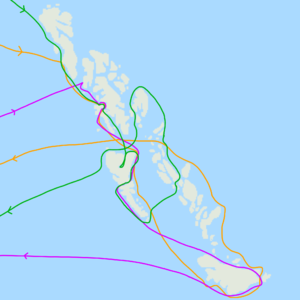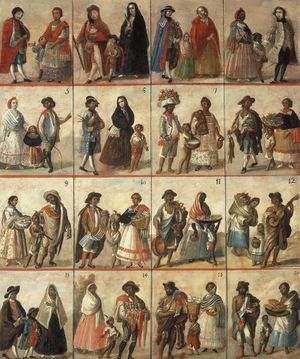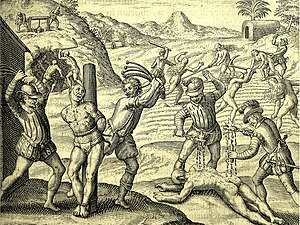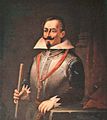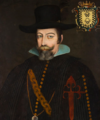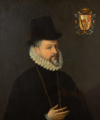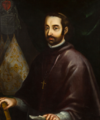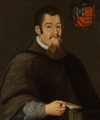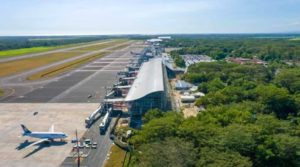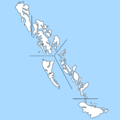San Carlos Islands
San Carlos Islands Իսլաս Սան Ծարլոս – Islas San Carlos ᓌ ᐘᐃᓇ ᐕᐗᐅᑱ ᒹᑯᐊᐷᐁ ᑺᐳᓇ – Nā Āina Uaoko Mākoupoe Kūpuna | |
|---|---|
| Captaincy General and Department of the San Carlos Islands | |
| Nickname(s): Նփեվո Սալվադոր/Nuevo Salvador (New Savior) | |
| Motto(s): Վիվա յ Սալվե լաս'Իսլաս Սան Ծարլոս Viva y Salve las'Islas San Carlos (Hail and Praise the San Carlos Islands) | |
| Anthem: Վիվա յ Սալվե/Viva y Salve (Hail and Praise) | |
 Map of the San Carlos Islands | |
| Country | |
| Creeperian landing | 12 October 1381 |
| Captaincy General | 1 June 1387 |
| Department status | 19 January 1888 |
| Founded by | Cristóbal Colón Cámarillo |
| Named for | Saint Carlos |
| Capital and largest city | |
| Government | |
| • Type | Departmental captaincy general |
| • Emperor | Alexander II |
| • Captain General | Sergio Tejón Galdámez (IC) |
| • Viceroys of the General Courts | Eduardo Monterrosa Sandoval (IC) Romero Carpio Barranca (IC) |
| Area | |
| • Total | 79,130 sq mi (204,900 km2) |
| Highest elevation | 6,421 ft (1,957 m) |
| Lowest elevation | 0 ft (0 m) |
| Population (2020) | |
| • Total | 8,517,685 |
| • Rank | 28th |
| • Density | 107.64/sq mi (41.57/km2) |
| Demonyms | San Carlos Islander, San Carlosian |
| Demographics | |
| • Ethnicity | 85.45% Natizo 9.16% Creeperian 5.28% Native Islander 0.11% Other |
| • Religion | 95.52% Creeperian Catholicism 4.43% Native religions 0.05% Other |
| Economy | |
| • GDP nominal | ₡3.52 trillion colóns[note 1] |
| • GDP per capita nominal | ₡381,559 colóns[note 2] |
| Time zone | AMT+8 (ISC) |
| Area code(s) | 9 |
| Vehicle registration | S AA-0000-A |
| Claimed by | |
| Website | islassancarlos.gob.cr |
Part of a series on the |
|---|
| History of San Carlos Islands |
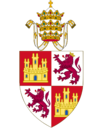 |
The San Carlos Islands (Jackian pronunciation: [sæn kɑːr.loʊs aɪ.lɛnds]; Creeperian Spanish – Creeperian: Իսլաս Սան Ծարլոս; Creeperian Spanish – Iberic: Islas San Carlos; Creeperian Spanish pronunciation: [iz.las san kaɾ.los]; literally translated as the Islands of Saint Charles; Native Islander: ᓌ ᐘᐃᓇ ᐕᐗᐅᑱ ᒹᑯᐊᐷᐁ ᑺᐳᓇ; transliterated as: Nā Āina Uaoko Mākoupoe Kūpuna; Native pronunciation: [naː ˈaːi.naː u.ɐˈoː.ko maːˈkoːuː.po.ɛ kuːˈpuː.nɐ]; literally translated as the Rainy Lands of Our Ancestors), officially the Captaincy General and Department of the San Carlos Islands (Creeperian Spanish – Creeperian: Ծապիտանձա Գեներալ յ Դեպարտամենտո դե լաս'Իսլաս Սան Ծարլոս; Creeperian Spanish – Iberic: Capitanía General y Departamento de las'Islas San Carlos), and commonly abbreviated as SCI and ISC, is a department of Creeperopolis which is located in Ostlandet, the only Creeperian department not located in Sur. The islands are located completely in the Southern Ocean and are geographically close to New Gandor and Ajakanistan.
The precursor to the modern department was the Captaincy General of the San Carlos Islands, which was established on 1 June 1387 after being landed on by the Creeperans under Cristóbal Colón Cámarillo on 12 October 1381. The islands were governed by the Creeperian Navy from 1387 until 1565, and during that period, several revolts by the Native islanders were crushed by the Creeperian administrators, with the most notable revolt being the Great Revolt of Esclaveta in the early 1440s. In 1565, the islands were democratized and the islanders were able to vote for their Captain General, or regional governor. The islands returned to Naval administration from 1788 until 1887, when the islands were again democratized. In 1888, under Captain General Simón Bonilla Vásquez, a referendum was held in which the islands voted to become a department of Creeperopolis. In 1918, under Captain General Antonio Gutiérrez Avendaño, another referendum was held on wether the islands should gain independence, but the referendum failed and the islands remained a department of Creeperopolis. The San Carlos Islands sided with the Catholic Imperial Restoration Council during the Creeperian Civil War of 1933 to 1949. The Creeperian Army then administered the islands from 1949 until 1962, when the Creeperian Initiative began its governance over the islands.
On 12 October 1981, the Juan Horacio Palafox Mendoza Revolutionary Council (CR–JHPM) was formed and declared independence for the San Carlos Islands. Other groups, including the Kapahu Alana Revolutionary Movement (MRKA) and the Norental-Esclaveta-Pescante-Orisla-Colón Front (Frente NEPOC), would also form, beginning the San Carlos Islands Crisis. The 1995 Ankarabad Accords ended the San Carlos Islands Crisis on 13 March 1995 and granted the San Carlos Islands a degree of autonomy, however, the Kapahu Alana Revolutionary Movement was reformed in 2003 following the 2003 Creeperian coup d'état, reigniting a low-level insurgency on the island of Esclaveta. Autonomy for Esclaveta has since been revoked and the islands have since been the garrison of the 21st Creeperian Army. The San Carlos Islands have been considered and called the "last remnant of the Creeperian Colonial Empire." Since 15 May 1986, the Norentaleñan islands of Isla Verde, Paleto, Punto Norentisimo, and the northern half of the island of Admiral have been claimed by Ajakanistan, however, the Ajaki government does not have control of any of its claimed territory.
The current Captain General of the San Carlos Islands is Sergio Tejón Galdámez of the Creeperian Initiative who has been serving since 1 March 2011. As of 2020, the islands have a population of 8,517,685, making it the third least populous department of Creeperopolis. The capital and largest city of the department is Cámarillo, located in the municipality of Colón. The other four municipalities of the San Carlos Islands are Esclaveta, Norental, Orisla, and Pescante. The islands' highest point is Punto Colón, located on Esclaveta, which is also the largest island of the island chain. The majority of the population is ethnically Natizo, or a mix of ethnic Creeperian and ethnic Native islander, at over 85 percent of the population. The official language of the San Carlos Islands is Creeperian Spanish.
The San Carlos Islander economy is primarily supported by tourism, especially in the municipalities of Colón and Norental, mining, especially in the municipality of Orisla, and fishing, especially in the municipality of Pescante. The municipality of Esclaveta is considered to be a hindrance on the San Carlos Islander economy due to the constant military presence and influence in the municipality, scaring off potential tourists and investors. The San Carlos Islander economy is worth ₡3.52 trillion colóns[note 1] with a GDP per capita figure of ₡381,559 colóns,[note 2] making it one of the wealthiest departments of Creeperopolis.
Contents
- 1 Etymology
- 2 History
- 2.1 Formation of the islands
- 2.2 First human settlement
- 2.3 Creeperian arrival and exploration
- 2.4 First military administration
- 2.5 First Parliamentary Era
- 2.6 Second military administration
- 2.7 Second Parliamentary Era
- 2.8 Third military administration
- 2.9 Era of Peace
- 2.10 San Carlos Islands Crisis
- 2.11 Modern San Carlos Islands
- 3 Geography
- 4 Demographics
- 5 Government and politics
- 6 Economy
- 7 Infrastructure
- 8 Education
- 9 Culture
- 10 See also
- 11 Notes
- 12 References
- 13 Further reading
- 14 External links
Etymology
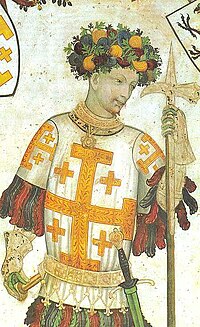
In 1381, the islands were first called The Imperial Islands of San Carlos the Martyr of Creeperopolis (Los'Islas Imperiales de San Carlos el Mártir de Creeperópolis), named after Saint Carlos, a son of King Alfonso I of Creeperopolis who died during the Creeperian Crusade. One of his attributes as a Saint was gold, and since the Creeperans were gifted gold by the Natives when they first arrived on the islands on 12 October 1381, the islands were named after Saint Carlos.
Overtime, the name has been shortened to simply the San Carlos Islands (Islas San Carlos). The official name was changed to the Captaincy General of the San Carlos Islands (Capitanía General de las'Islas San Carlos) on 15 May 1421, and later to the Captaincy General and Department of the San Carlos Islands (Capitanía General y Departamento de las'Islas San Carlos) on 19 January 1888 when the islands became a department.
The San Carlos Islander Natives called the islands Nā Āina Uaoko Mākoupoe Kūpuna (ᓇ ᐊᐃᓇ ᐅᐊᐅᑯ ᒪᑯᐊᐳᐁ ᑯᐳᓇ; translated as Rainy Lands of Our Ancestors). During the first military administration, the terms San Carlos Islands and simply Nā Āina were interchangeable, as there was still a significant population of Native islanders which was larger than the population of Creeperans. The names Nā Āina Uaoko Mākoupoe Kūpuna and Nā Āina both began to fall out of use during the First Parliamentary Era, and by the second military administration, the name San Carlos Islands became the official name to reference the islands.
When the Quebecshirites spotted the islands in 1301, they were named Gandeur du Sud, translated as South Gandor. The islands were continued to be called South Gandor in the Quebecophone world until 1932, when Quebecshire officially began referring to the islands as the Îles de Saint Charles during the Speakership of Yves-François Bourassa.
History
Formation of the islands
The San Carlos Islands were formed by volcanic activity in the Southern Ocean over an area known as the San Carlosian hotspot when underwater magma formed the islands. The first islands to form were in Norental around 3.5 million years ago. The islands of Orisla formed around 2.7 million years ago, the islands of Colón formed around 2 million years ago, the islands of Pescante formed around 1.4 million years ago, and the islands of Esclaveta formed around 1.1 million years ago. The San Carlosian hotspot is considered to be extinct, as the last volcanic eruption in the San Carlos Islands is estimated to have been 120,000 years ago.
First human settlement
The earliest human presence on the San Carlos Islands has been dated to around 3500BC in modern-day Colón. Modern DNA analysis has discovered that the earliest inhabitants of the islands were more ethnically related to modern Creeperans than to Gandorians as was previously believed. Historians have proposed that prehistoric Creeperans travelled to the San Carlos Islands from Sur using canoes, or other forms of boats, as a part of the Prehistoric-Creeperian Diaspora, which also occurred at around the same time period. This hypothesis is supported by the natural and genetic resistance Native San Carlos Islanders have to the Creeperian Malaria disease, and that the disease itself was already present on the islands before the Creeperans first arrived on the islands in 1381.
Very little is known about the Natives of the San Carlos Islands before contact was made with the Creeperans in 1381. Most of the information known about the Natives came from interactions between Creeperans and Natives during the late 1300s and early 1400s where they wrote down their oral traditions for the first time, however, those writings have since been mostly lost. The Natives were not organized into nation-states, but instead lived in tribes which made contact with each other.
The Natives of the island built villages across the archipelago and developed unique tribal affiliations. Different ethnicities even appeared overtime. Warfare did occur between tribes, but such warfare was not common and few deaths occurred. An exception, however, is the legendary and semi-mythical Battle of the Nations, in which, according to oral tradition, one million Natives from dozens of tribes across the archipelago engaged in battle on the modern-day island of Isla de Oro, during which, seven hundred-fifty thousand Natives died. The historicity of the battle is generally rejected by modern historians, however, a minority of historians argue that the battle did occur but that only around one thousand Natives engaged in battle. It is also a topic of debate on wether the Natives employed the use of slavery or not.
Creeperian arrival and exploration
Landing and explorations of the islands

In the early 1300s, Quebecshirite Captain Félix Vernier encountered a group of islands southwest of New Gandor and named them Gandeur du Sud, translated as South Gandor. Vernier never stepped foot on the islands but their location was documented.
Meanwhile, the Creeperian Crusade concluded in 1345 in Creeperopolis with the fall of Shata' Albahr. King Miguel I died in 1365 and was succeeded by his son, Adolfo I, who was made aware of the islands' existence and he wanted to conquer new lands like his father had done. Internal economic issues prevented the Creeperans from sending an expeditionary force to the islands during the 1360s and 1370s, but in 1380, the Creeperian Navy was able to gather enough money, support, and resources to fund a voyage to the islands.
The voyage east was led by Admiral Cristóbal Colón Cámarillo and composed of three ships: the Rey Alfonso I, the Rey Felipe I, and the Rey Machtitín I. The ships left the port of Salvador on 18 April 1381 and headed east across the Southern Ocean. On 12 October 1381, Colón Cámarillo landed on the largest island in the north of the archipelago which he called La'Isla Gran del Admiral, later known as simply Admiral, the island's current name. The Creeperans met with some Natives of the island and they were introduced to their village. The two exchanged gifts; the Creeperans gifted the Natives hammocks and crosses while the Natives gifted the Creeperans beads, candles, whale bone tools, and gold. After a few days, the Creeperans departed, believing that the island was rich in gold. As the ships departed, Colón Cámarillo named the islands Los'Islas Imperiales de San Carlos el Mártir de Creeperópolis, translated as The Imperial Islands of San Carlos the Martyr of Creeperopolis.
The Creeperans then headed south and explored more of the islands of the archipelago, naming all of the ones they came across. They landed on the island of Orala and established their own settlement called of San Nicolás. The Creeperans worked with the Natives there and were able to live off of food provided by the Natives. Creeperian Catholic priests taught the Natives Creeperian Spanish in order to better communicate with the Natives and many were even converted to Catholicism. The Creeperans traveled north along the eastern coast of the archipelago. The Creeperans then returned to Creeperopolis and arrived to Salvador on 18 March 1382. Colón Cámarillo showed Adolfo I the gold they were gifted and he immediately began preparations for a second voyage to begin finding good locations to make permanent settlements.
On 17 November 1383, Colón Cámarillo commanded the same three ships and traveled to the San Carlos Islands with the mission of finding locations that would be perfect to establishing permanent settlements. The Creeperans carried coffee with them this time as gifts for the Natives and as bribes so that they would be willing to live under Creeperian rule. Colón Cámarillo and his fleet landed on the island just south of Admiral on 15 March 1834. They established a temporary settlement and continued to San Nicolás a week later. They arrived on 26 March 1834 and reunited themselves with the Natives still living there. Colón Cámarillo established a permanent settlement at San Nicolás. They stayed there for two months, improving relations with the natives, trading goods, and building up the settlement. Of the 1,200 men on the journey, 400 stayed behind to maintain the settlement and continue relations with the Natives. Colón Cámarillo placed Pedro Gutiérrez Valdivia, his second-in-command, in charge of San Nicolás and the Creeperans departed on 13 June 1384. They sailed south, following the same route as the first voyage, and again sailed along the coast of the island of Cámarillo. Colón Cámarillo continued to follow the coast and encountered a large Native settlement on the island on 24 June 1384. The settlement was home to 30,000 Natives and both had a friendly initial interaction. Both groups traded gifts and the Creeperans settled there for three months. They were treated as guests and the Creeperans helped the Natives develop the settlement. Colón Cámarillo named the settlement Ciudad Grande del Admiral Cristóbal Colón Cámarillo, after himself. The city is know known as simply Cámarillo. The Creeperans departed the city on 1 September 1384 and carefully charted down its location since Colón Cámarillo wanted to make the settlement the islands' capital city.
The Creeperans headed west and then south and realized that the island was smaller than they initially believed. They named the new island La'Isla Santa de Santa Catalina, translated as The Holy Island of Santa Catalina, known today as simply Santa Catalina. The ships sailed around Isla Adolfo I and settled briefly on the island near a Native settlement of 200 people on 30 September 1384. There, Colón Cámarillo established the settlement of San Jerónimo de la'Virgen María, as he settled it on the feast day of Saint Jerome. During their stay there, a fight broke out between the Natives and the Creeperans which left 4 dead on each side. The Natives demanded that the Creeperans never return to their island and the Creeperans left the next day. It was 5 October 1384 and Colón Cámarillo began the journey back to Creeperopolis. He arrived to Salvador on 13 February 1385.
When he returned, he arrived to a country fighting another war against the Deltinians. While he was gone, in 1384, the Deltinians, under the leadership of Caliph Orhan III bin Abu Zaidi, revolted against Adolfo I in the departments of Abdan, Helam, and Jakiz. As a result, plans for a third voyage were put on hold, but plans were made nonetheless.Adolfo I died on 2 May 1385 and was succeeded by his son, Miguel II. Under Miguel II, the Deltinian rebellion was mostly crushed with some holdouts in Abdan that would be fully defeated in 1403. In 1387, Miguel II authorized the third voyage to officially claim the San Carlos Islands as a colony of Creeperopolis.
Establishing of the Captaincy General
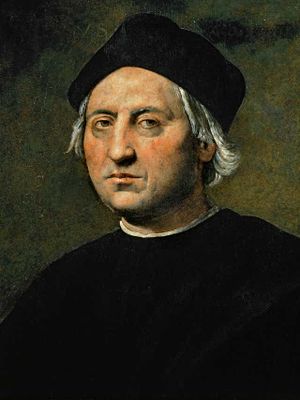
On 1 June 1387, Miguel II proclaimed the establishment of the Captaincy General of the San Carlos Islands to govern the San Carlos Islands in representation of the monarchy. He proclaimed Colón Cámarillo as the Capitan General of the Captaincy General and he began his final voyage to the San Carlos Islands. He would never see Creeperopolis again. The same three ships were taken, but six additional ships were also carrying hundreds of Creeperian families to settle the islands. Around 4,500 Creeperian men, women, and children were aboard the nine ships.
Colón Cámarillo's fleet arrived at the northernmost tip of Admiral and continued south until they reached San Nicolás. There, 1,000 of the settlers departed and permanently settled in San Nicolás. Colón Cámarillo replaced Gutiérrez Valdivia with Francisco Villagra Velázquez as being in charge of San Nicolás and appointed him as Mayor, the first Creeperian Mayor in the San Carlos Islands. Colón Cámarillo and Gutiérrez Valdivia took seven of the nine ships to Cámarillo where 3,500 more settlers permenently stayed. Colón Cámarillo appointed Gutiérrez Valdivia as Mayor of Cámarillo and made it the capital city of the Captaincy General on 15 September 1387. The name of the city was also officially changed to Cámarillo. One ship with 500 men commanded by Diego Kassandro Moreno was sent to continue exploring the archipelago and continue mapping the are and return to Creeperopolis. The ship continued to navigate the archipelago and returned to Salvador on 3 February 1388, ending the three voyages of Colón Cámarillo.
Colón Cámarillo expanded the city of Cámarillo during his tenure as Captain General of the San Carlos Islands, growing it from a small village to a proper city, the largest on the island. Creeperian settlers and Natives coexisted in the city and actively traded with each other. Colón Cámarillo even appointed several Natives to administrative jobs in Cámarillo and across the archipelago. In 1392, the Creeperian Catholic Church permitted interracial marriages between Creeperans and Natives, producing the first children of a mixed race on the island.
First military administration
The Enslavement
- Top left: Pedro Gutiérrez Valdivia (1392–1412)
- Top right: Gustavo Hurtado Mendoza (1412–1427)
- Bottom left: Miguel Quiroga López (1427–1463)
- Bottom right: Melchor Bravo Saravia (1463–1477)
Colón Cámarillo died on 22 April 1392 and was succeeded as Captain General by Gutiérrez Valdivia, his second-in-command who he had appointed as Mayor of Cámarillo. Although Colón Cámarillo officially retired from military life when he assumed command as Captain General, Gutiérrez Valdivia remained on active military duty and continued to command soldiers in battle.
Under Gutiérrez Valdivia, all Natives were expelled from administrative positions, undoing the work of Colón Cámarillo. He also increased commitment to subjugating and enslaving the Natives on Isla Adolfo I, which has since been known as Esclaveta, earning him the nickname "El Esclavizador," meaning "The Enslaver." During his tenure, brutal punishments were introduced against slaves who violated laws or codes of conduct, including torture and death. A caste system, known as the Casta, was also introduced as a form of segregation and established a racial hierarchy. The period has become known as "The Enslavement" and is considered the worst period of Creeperian rule in the San Carlos Islands. He established the city of Anadesa to serve as an outpost for transporting slaves between the islands, and he continued to use the settlement of San Jerónimo de la'Virgen María as a secondary port for transporting slaves within Esclaveta.
In 1402, Gutiérrez Valdivia ordered the construction of two Creeperian Catholic missions on the archipelago: the San Carlos Mission in Cámarillo and the San Nicolás Mission in San Nicolás. Both missions were completed and consecrated by the Church in 1411. Both missions were constructed by Native slaves overseen by Creeperian supervisors. Of the missions, San Nicolás is still in active use today, while San Carlos was destroyed during the Creeperian Civil War in 1938. Both were listed as Creeperopolis National Historical Landmarks on 8 June 1970.
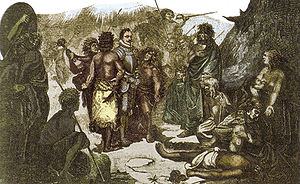
Gutiérrez Valdivia was assassinated on 3 May 1412 by several of his Native slaves outside the San Carlos Mission in Cámarillo. He was stabbed and beat to death by several of his slaves who sought to end his reign of terror. Gutiérrez Valdivia was succeeded by Gustavo Hurtado Mendoza, the Mayor of Cámarillo, who had the slaves publicly tortured to death in front of the San Carlos Mission. The slaves' entire families were also put to death due to their relations to the assassins. News of the assassination spread across the islands, and when it reached Esclaveta, the slaves staged an uprising against the Creeperans. During the revolt, the settlement of San Jerónimo de la'Virgen María was destroyed and abandoned, and its location was eventually lost. The revolt was crushed by the end of the year by Hurtado Mendoza's forces. He was the first member of the later to be very influential Mendoza Family to serve as Captain General of the San Carlos Islands. Hurtado Mendoza had two large statues of Colón Cámarillo and Gutiérrez Valdivia constructed in front of the San Carlos Mission in 1417 in their memory for what they have contributed to the islands. Neither statue stands today as they were both destroyed in the Creeperian Civil War.
The Isla de Oro gold mine was established in 1387 by Colón Cámarillo and had been manned by slaves since 1389, but since then, the mine had begun to run into financial issues as less and less gold was being discovered. In 1419, Hurtado Mendoza opened a new mine 3 miles south of the old mine, officially abandoning the old mine in 1421 after two months without finding any gold. The new mine was excavated and mined by Native slaves, with regimes being extremely rough and difficult at 12-hour work days every day of the week. Most of the gold mined went directly to Creeperopolis, while the remainder of the gold went into the San Carlos Islander economy or foreign buyers.
Hurtado Mendoza resigned as Captain General on 12 December 1427. He was succeeded by Miguel Quiroga López. Hurtado Mendoza died of a stroke on 19 December 1430, although many suspected he was poisoned by one of his slaves or some other Native sympathizer. As a result, Quiroga López had 62 slaves put to death, one for every year of Hurtado Mendoza's life, on 1 January 1431. New of the massacre spread, and slaves on Esclaveta revolted for a second time. Although suffering initial setbacks in the early months on the revolt, the Creeperans managed to put down the revolt by October 1431.
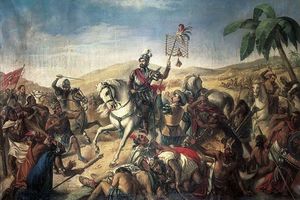
Quiroga López increased the quotas expected from the slaves working in the gold mines in 1435. Slaves working on construction sites were also given twice the work as they already had. They were forced to build many roads to and from mines and ports and to and from the capital and villages on the island of Cámarillo. Natives across the colony were forced to work harder and harder, and many desired independence. They cried out to Archbishop José Morales Herrador to intervene on their behalf, but he refused to do so. In 1439, a group of thirty Natives escaped from the Pensacola Plantation on Esclaveta, most of whom were teenage boys with a few teenage girls and women. They decided to help other slaves escape and organize a third revolt. Led by seventeen year old Kapahu Alana, they began planning the most well thought out revolt of The Enslavement period. In 1440, the slaves stole guns from the plantation and later attacked it on 2 March 1440, killing all Creeperans present and freeing all the slaves there. The plantation was burned down and destroyed and the Natives declared independence from the Captaincy General for the Natives of Esclaveta as Lahui Kuokoa, meaning "Nation of Freedom" in the Native language with Kapahu I as its leader.
News of the revolt spread across the Captaincy General and inspired many more enslaved Natives in other parts of the islands to also revolt. Slaves working in mines, construction sites, and plantations across the islands rose up against the Creeperans, causing confusion and setbacks for the military who began preparing to put down the revolt in Esclaveta. On 15 July 1440, 153 Creeperans on Esclaveta were massacred by the revolting Natives, the first time Creeperans were massacred by Natives in large numbers. Quiroga López reacted by ordering military forces to take no prisoners and kill any and all Natives they came across. By the end of the year, Kapahu I declared Lahui Kuokoa to be free of Creeperans claiming to have killed or enslaved 1,000 Creeperans and forcing the remainder to leave. The claim was refuted by the government of the Captaincy General and claimed that they still held control of the island. By 1441, all revolts outside of Esclaveta had been put down, with 12,000 Natives being killed.
The Creeperans prepared their landing on Esclaveta for 18 July 1441. The Creeperans, led by José Hernández Córdoba, landed near the capital of Anadesa and fought with the Natives to regain control of the city. The Creeperans were victorious, but the revolt was not crushed. The city was set on fire by the Natives, inflicting heavy casualties amongst the city's inhabitants. The Creeperans marched inland to recapture the ruins of Pensacola with the intentions to capture Kapahu I. The armies of Hernández Córdoba and Kapahu I engaged at the ruins of the plantation on 13 August 1441 at the Battle of Pensacola. The battle ended in a decisive Creeperian victory with most of the Native army being killed or recaptured to used for slave labor. Kapahu I, however, evaded capture and fled west to raise another army. Hernández Córdoba chased him down and engaged Kapahu I's rebuilt army at the Battle of Casadoble on 7 October 1441. Kapahu I's army was again defeated, with most of the army being captured and the remainder killed. He again evaded capture and fled north. Kapahu I and thirty other Native warriors boarded a boat and travelled north to the islands of Pescante to rally support there and continue the uprising, however, he never arrived and was never seen again. He is assumed to have drowned at sea after the boat sank for an unknown reason or the boat was swept out to sea and they died of starvation.

Kapahu I said his armies would be ravaging Pescante by January 1442, but since that did not happen, the Natives still on the run on Esclaveta proclaimed a new leader: Kila I. He marched on Pensacola to recapture the area, but he ran into Hernández Córdoba's army on 17 February 1442 near the village of Hanola. During the battle, Kila I and the Natives were decisively defeated, ending the Great Revolt of Esclaveta and bringing an end to the Native declared nation of Lahui Kuokoa. Kila I was captured and burned alive by the Creeperans on 19 February 1442. The war killed an estimated 45,000 Natives.
Following the uprising, working conditions were made even harsher for the Natives as a punishment for the revolt. All men above the age of eighteen were also castrated, eventually leading to a decrease in the Native population over the next 30 years. Quiroga López resigned on 1 March 1463 and was succeeded by Melchor Bravo Saravia. He traveled to Esclaveta and met with Natives to discuss the status of slavery on the islands. They came to a compromise and Bravo Saravia agreed to abolish slavery for women, children, and the elderly, beginning the path to abolition on the islands. He died on 14 July 1477.
The Liberation
Following Bravo Saravia's death, Martín Óñez Barrera assumed office as Captain General. On 18 August 1478, after pressure from Native slaves and his Native wife, he signed the Proclamation of Liberation which completely abolished slavery across the archipelago and made the practice of slavery illegal. The move was met with severe criticism from the wealthy Creeperian landowners who refused to give up their slaves, but Óñez Barrera sent military forces to coerce slaveowners into releasing their slaves or arrested them if they continued to refuse, beginning a period known as "The Liberation."
On 13 June 1482, Óñez Barrera decreed that Natives would fill in governance of the municipalities of the islands instead of Creeperans. Natives would be installed once the incumbent Creeperian governors resigned, died, or was removed. On 19 December 1482, the first Native was appointed after a governor on Norental resigned. The appointment marked the first time since 1392 that Natives had a say in the governance of the islands. By 1500, most of the municipalities had been replaced with Natives. The last municipality in Pescante to be replaced with a Native occurred on 14 September 1506. Óñez Barrera was very unpopular amongst the Creeperian population, and he was eventually forced to resign on 29 June 1515 under pressure from Creeperian landowners.
He was replaced by Blasco Núñez Vela, a relative of Mendoza Hurtado, and many landowners thought he would reverse Óñez Barrera's policies, but he continued his policies and allowed greater autonomy for the Native governors to have more freedom to govern their municipalities. Óñez Barrera died on 18 December 1519, and many suspected he was assassinated. Núñez Vela had one hundred twenty Creeperian landowners arrested in relation to the suspected assassination. After two years of investigating, he concluded that Óñez Barrera has in fact been poisoned and that twenty-three of the one hundred twenty arrested were involved. Those wrongly imprisoned were monetarily compensated while the twenty-three involved were publicly hanged.
On 12 October 1522, Gustavo Robles Castañeda, the wealthiest landowner on Esclaveta, made agreements with thirty other landowners on the island and proclaimed the establishment of the Republic of Esclaveta, declaring independence from the Captaincy General and declared that slavery was legal. Paramilitary forces of the landowners attacked Native populations and forcibly enslaved them. Natives created resistance groups and fought back against the landowners. Núñez Vela sent the military to crush the republic and arrest the landowners. By 1524, the republic was crushed and the thirty landowners were captured and executed. The land held by the thirty were seized by the government and put up for sale to be redistributed.
In 1535, the Honduran Genocide occurred in Creeperopolis under orders of King Miguel V. News of the genocide that killed 1.2 million Hondurans reached the San Carlos Islands in 1536 and caused serious concern within the government and among Native populations that landowners would initiate their own genocide. The concerns were nullified when no genocide occurred against the Native population, but Núñez Vela distanced his government from the government in Creeperopolis. Fearing treachery, Miguel V had Núñez Vela replaced with Diego López Zúñiga who he believed was more loyal to his government. When Miguel V was assassinated on 1 September 1555, his successor, Miguel VI, was killed on 3 September 1555, and succeeded by Alfonso III, López Zúñiga swore his allegiance to Alfonso III. López Zúñiga died on 15 October 1563 and was succeeded by Jerónimo Cabrera Salinas.
First Parliamentary Era
Pacheco Mendoza administration
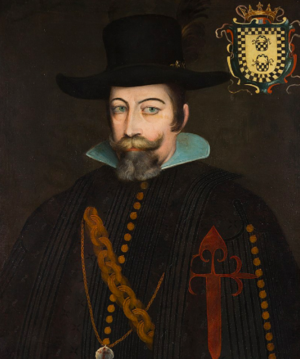
In 1564, protests against Alfonso III pressured him to establish democracy and the First Parliament of Creeperopolis was created with a general election being held in 1565. In Creeperopolis, the Conservatives defeated the Liberals and had elected Alfonso Moreno Salinas as Creeperopolis' first Prime Minister and the country's first ever elected official.
At the same time in the San Carlos Islands, Natives protested Cabrera Salinas' government and demanded the institution of democracy in the country. He accepted, and on 1 January 1565, the San Carlos Islands held its first ever election. Cabrera Salinas ran for Captain General as a Conservative, but he was defeated by Antonio Mendoza Pacheco who ran as a Liberal, beginning the period of "Parliamentization" that lasted from 1565 until 1580.
In the election, only the Captain General was elected; there was no legislature in place to vote for. Mendoza Pacheco assumed office on 1 March 1565 and immediately began work to establish a legislature and a judiciary for the Captaincy General. On 15 April 1565, he established into law the Establishment of a Legislature and Judiciary for the San Carlos Islands which outlined the national legislature and judiciary for the islands. The law established the Chamber of Representatives (CÁREP) and the Chamber of Islanders (CÁMIS). The Chamber of Representatives was the legislature's upper house and it was composed of twenty-five elected ethnic Creeperian representatives, five from each of the Captaincy General's five municipalities. The Chamber of Islanders was the legislature's lower house and it was composed of fifty elected ethnic Native representatives, ten from each of the municipalities. The judiciary was composed of five justices who were nominated by the Captain General and approved by both houses of the legislature.
He scheduled the first legislative election for the houses for 1566. He also set elections for every three years to offset it from the Captain General who served as the executive, however, he had to change his decision to make all elections for all seats for both chambers to be conducted the same year as the Captain General after pressure from Moreno Salinas. In the election, the Liberals won a majority and the houses entered session on 1 March 1566, and as a result, the first term of both chambers was only four years long. By 1567, all the justices had been nominated and approved.
On 1 January 1568, Mendoza Pacheco made a statement which denounced the islands' past of slavery and war. He heavily criticized the Captaincy Generalships of Gutiérrez Valdivia, Hurtado Mendoza, Quiroga López, and Bravo Saravia, during which, slavery was rampant and warfare with the Natives of the islands was constant. He aligned himself with the Natives of the islands, and in tern, the Liberal Party also aligned with the Natives. He associated the Conservatives with the "regime of slavery" of The Enslavement. Cabrera Salinas defended himself and the Conservatives, also denouncing the use of slavery and torture and the constant warfare, in an attempt to maintain favor with the Natives.
Mendoza Pacheco was reelected as Captain General in the 1570 gubernatorial election, again defeating Cabrera Salinas and the Conservatives. In July 1572, the Middle Isla de Oro gold mine collapsed, killing 112 miners, mostly Natives and Natizos, inside the mine during the collapse. The overseers of the mine, who were hired by the government, were promptly arrested under the suspicion that had allowed the condition of the mine to deteriorate to the point of collapse. The six defendants: José Pérez Pérez, Miguel Hidalgo Melléndez, Óscar Tejón Jiménez, Antonio Mellingro Núñez, José Rosales Herrador, and Ramiro Ugarte Guerrero, were charged with negligence and 112 counts of murder, each. The six were judged guilty of the charges presented against them and they were sentenced to death. The executions were conducted on 18 October 1572 in Cámarillo. The incident was considered a victory for the new legal system by Mendoza Pacheco and the Liberals in combatting corruption and negligence in the islands. Because of the collapse of the mine, Mendoza Pacheco's government financed the opening of the New Isla de Oro gold mine, which opened in 1574. The event was considered a disaster for the Conservatives, as the six men sentenced to death were prominent supporters of the Conservatives, and as such, the Liberals won the 1575 gubernatorial election.
In 1578, Mendoza Pacheco announced that he would be retiring following the 1580 gubernatorial election and that he would be stepping down as Captain General when his term ended. As a result, the Liberals nominated José Guzmán Álvarez as their candidate for Captain General. The Conservatives continued to support Cabrera Salinas in the election. On 24 December 1579, one week before the election was due to occur, Guzmán Álvarez died from a stroke and the Liberals were unable to nominate a new candidate for Captain General, and as such, Cabrera Salinas ended up winning the election and became Captain General on 1 March 1580 after fifteen years of being out of office.
Suárez Mendoza administration
Cabrera Salinas attempted to appeal to the Natives by labeling himself as the man who brought democracy to the San Carlos Islands, and his strategy did work to an extent, as the Natives voted to reelect him in 1585. Cabrera Salinas died in office on 12 June 1588 from a heart attack, and he was succeeded by Conservative Felipe Suárez Mendoza. Suárez Mendoza was Mendoza Pacheco's cousin, sharing a grandfather in Alexander Mendoza Abellán, a prominent mine owner in Orisla. He utilized his name recognition and family relation to sway the Natives to support him and his conservative policies. He even turned against Cabrera Salinas' declaration that he brought democracy to the islands, instead, saying that Mendoza Pacheco and the Mendoza Family brought democracy to the islands. Mendoza Pacheco himself did not support using him and his family's name as a political tool and denounced his cousin. Suárez Mendoza managed to win reelection in 1590, but with the vocal support of Mendoza Pacheco, the Liberals won the 1595 gubernatorial election and Luís Velasco Castilla became Captain General.

On 12 October 1598, a 6.8 magnitude earthquake shook Colón and caused the deaths of 4,118 people. Many buildings in the city were destroyed, and the seismic waves were felt as far away as Norental and Esclaveta. In the year following the earthquake, Velasco Castilla and the Liberals were unable to rebuild the city to the point that it had been before the earthquake, and out of anger and impatience, the people reelected Suárez Mendoza and the Conservatives and gave them a chance to fix the situation in the 1600 gubernatorial election. When Suárez Mendoza took office on 1 March 1600, he declared that Colón would be fully rebuilt by 1 July 1600. The following day, 2 March 1600, however, Mendoza Pacheco died in his home from illness. Suárez Mendoza declared two weeks of mourning for Mendoza Pacheco, and pushed back his promised date to 15 July 1600. On 14 July 1600, the day before he promised the city would be rebuilt by, the San Carlos Mission was completely rebuilt, and he declared the city to be restored to its pre-earthquake state. Although some buildings were completely demolished, the majority of the city was restored, which greatly boosted his and the Conservative's popularity with the people.
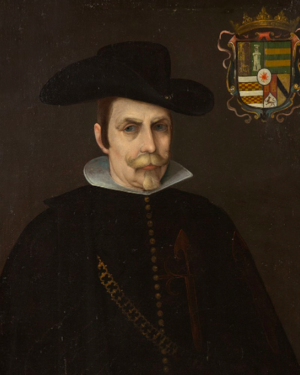
He was reelected as Captain General in the 1605 gubernatorial election, but he was now 73 years old, and many within both the Conservative and Liberal Parties feared that he may fall ill and die in office. Members from both parties urged him to retire in the following election and allow someone else to run for Captain General. He, however, refused, and stated that he will continue serving as Captain General until he died or until the people voted him out of office.
His son-in-law, Miguel Mendoza Salinas, who himself was distantly related to Suárez Mendoza, being his fifth cousin once removed, criticized Suárez Mendoza, and even stated his intentions to run against him as a Liberal for Captain General. Suárez Mendoza defeated Mendoza Salinas in the 1610 gubernatorial election, then again in the 1615 gubernatorial election, 1620 gubernatorial election, and the 1625 gubernatorial election. Suárez Mendoza outlived Mendoza Salinas as he eventually died on 17 September 1625. Suárez Mendoza won the 1630 gubernatorial election, and in 1631, he announced that he would not be seeking reelection in 1635. Mendoza Salinas died on 4 March 1632, aged 100, becoming the longest living Captain General in San Carlos Islander history. He was succeeded by Alvaro Manriquede Zugniga, who would eventually be reelected in 1635 and again in 1640.
Lorenzo Suárez Mendoza, the grandson of Suárez Mendoza and the nephew of Mendoza Salinas, defeated Manriquede Zugniga in the 1645 gubernatorial election, marking the first time a Liberal held the position of Captain General in 45 years. Despite being the grandson of Suárez Mendoza, he ended up repealing many of the laws that Suárez Mendoza passed. He also reformed the judicial system and improved living conditions for Natives. His reforms and actions earned him reelection in 1650. Suárez Mendoza retired from political life and died not seek reelection in 1655, in which Manriquede Zugniga was reelected. Suárez Mendoza eventually died in 1657 to illness. Manriquede Zugniga continued governing the San Carlos Islands, and was reelected in 1660, but like his predecessor, he did not seek reelection and retired when his term ended, eventually dying in 1666 to illness.
Palafox Mendoza administration
He was succeeded by Liberal Martín Enríquez Almanza in the 1665 gubernatorial election. During his tenure, he began rebuilding the then decaying roads of Esclaveta and Colón. He also began encouraging Creeperans from the mainland to move to the San Carlos Islands, which gradually increased the population of the islands. He would go on to win reelection in 1670, 1675, and 1680, not meeting any serious competition from the Conservatives, as his tenure was popular and well received by both sides. In 1685, however, Enríquez Almanza was finally met by a genuine competitor: Conservative Juan Palafox Mendoza. Palafox Mendoza was a clergyman of the Creeperian Catholic Church who had recently just been elevated to the position of Archbishop of the San Carlos Islands on 27 December 1682 by Pope Luís XIV. Palafox Mendoza was also the great grandson of Mendoza Salinas. He eventually won the 1685 gubernatorial election, becoming the first and only clergyman ever to become Captain General of the San Carlos Islands.
Palafox Mendoza began implementing reforms which aimed at improving the standard of living for all San Carlos Islanders across the five municipalities. He celebrated the 300 year anniversary of the establishment of the Captaincy General of the San Carlos Islands on 1 June 1687 by celebrating mass at the San Carlos Mission, recording an attendance of 15,000 people. Throughout his term as Captain General, he would continue to carry our his ecclesiastical duties as Archbishop of the San Carlos Islands. He repeatedly has been encouraged to resign as either Archbishop or as Captain General, but he refused, and continue to carry out both of his duties and mandates. He won reelection in 1690.
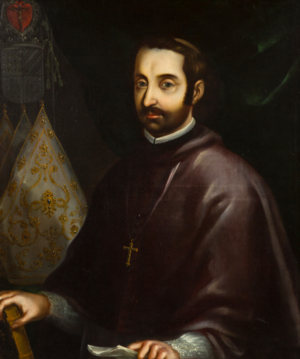
On 12 October 1692, Palafox Mendoza formally apologized for the actions of the Captaincy General during the Captaincy Generalships of Gutiérrez Valdivia, Hurtado Mendoza, Quiroga López, and Bravo Saravia, from 1392 to 1477, denouncing the actions of slavery, torture, mass execution, genocide, warring, and other atrocities as immoral and against the Will of God. He also symbolically pardoned all Native Islanders who were sentenced to death by Gutiérrez Valdivia, Hurtado Mendoza, Quiroga López, and Bravo Saravia, legally exonerating them in the Captaincy General. His action gained him significant support amongst the Natives of the islands. He also managed to encourage Pope Innocento XII to canonize Diego Cosnvarubias Torres, a Natizo who witnessed four apparitions of Our Lady of Guadeloupe in 1575, as a Saint in the Creeperian Catholic Church on 3 July 1694, further increasing his popularity with the Natives, which helped earn him reelection in 1695.
On 1 January 1696, Palafox Mendoza initiated a fundraiser to renovate the San Carlos Mission. The fundraiser was criticized by Liberals, who claimed that it was an abuse of power and misappropriation of government funds, using them to finance Church matters instead of government matters. Conservatives defended Palafox Mendoza, claiming that the funds being used were donations from the people of the San Carlos Islands instead of government appropriated funds. The issue was serious enough, that the Liberals proposed a serious candidate for Captain General for the 1700 gubernatorial election. The Liberals nominated José Barrie León, who swore that he would hold Palafox Mendoza accountable for misappropriation of government funds. Because of Palafox Mendoza's popularity among the Natives, a rarity for a Conservative politician, Palafox Mendoza soundly defeated Barrie León. He continued his fundraiser through his fourth term as Captain General, to the opposition of Liberal politicians. Barrie León challenged Palafox Mendoza again in the 1705 gubernatorial election, but Palafox Mendoza again defeated Barrie León. The fundraiser ended in 1707 and renovations began later that same year.
On 17 June 1708, Palafox Mendoza presented a proposal for a voluntary relocation program for San Carlos Islander Natives, where Natives living in Colón, Norental, Orisla, and Pescante would move on a voluntary basis to Esclaveta in order to establish a more homogeneously Native area of the islands which would maintain some degree of autonomy from the other four municipalities. The proposal was moderately supported by Native representatives in the Chamber of Islanders and in the Chamber of Representatives, and in tern, by the Creeperian and Natizo representatives in both houses. On 27 June 1708, both chambers passed the Voluntary Native Relocation Plan with strong majorities. In the first year, around half of the islands' Natives voluntarily relocated to Esclaveta, which accounts to the noticeable Native population discrepancies in the modern-day San Carlos Islands, and overtime, the Natives who voluntarily relocated assimilated to become practically ethnic Esclavetans. In 1709, Palafox Mendoza also proposed renaming Esclaveta to "Nuevo Libertad" in an effort to remove the mark of slavery in the municipality, but the proposal was opposed by Natives in both chambers, as they have grown to strongly identify with the term and have began to accept and own the label as "Esclavetan." Palafox Mendoza acknowledged the will of the Natives and withdrew his proposal. He won reelection in 1710.
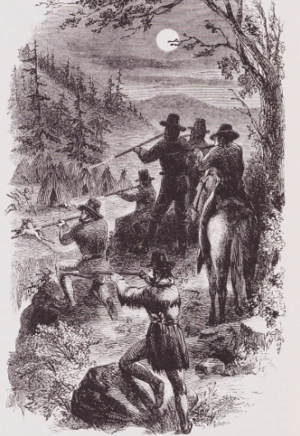
On 3 May 1712, seventeen Natives on the outskirts of Cámarillo were murdered by Creeperans in revenge for the murder of Gutiérrez Valdivia exactly three centuries earlier. The Cámarillo massacre was met with outcry by Native populations across the islands over the following months. Palafox Mendoza condemned the massacre and called for the arrest of everyone involved in the massacre. On 6 May 1712, Palafox Mendoza held a funeral service in a local church for the seventeen murdered Natives. He then allowed Natives to preform their own funeral service abiding by their own religious customs, as only four of those murdered were actually Catholic, in effect, granting the seventeen Natives both a Catholic and Native funeral. The gesture was appreciated by the Natives of the San Carlos Islands. By July 1712, twenty-six people with connection to the massacre were arrested. They were tried on 1 September 1712, and in the trial, one was acquitted, six were sentenced to 25 years' imprisonment, fourteen were sentenced to life imprisonment, and five were sentenced to death. The executions were carried out on 30 September 1712. His action against crimes being committed against Natives only increased his support, and he earned another reelection in 1715.
Palafox Mendoza welcomed a visit from King Carlos II in March 1716, marking the first time a Creeperian monarch had ever stepped foot in the San Carlos Islands. The visit was followed by a visit from Prime Minister Salvador Cerén Collazo in March 1717, marking the first time a Creeperian Prime Minister ever stepped foot in the San Carlos Islands. Palafox Mendoza himself made a visit to Creeperopolis in March 1718.
On 31 May 1719, Palafox Mendoza ordained 34 Native priests and assigned them to churches across the San Carlos Islands with the intention of converting many of the remaining non-Catholic Natives to Catholicism. Following the ordinations, Palafox Mendoza announced the establishment of the Society of Native Islanders as a Catholic order for Native priests to become members of to further spread the teachings of the Creeperian Catholic Church into Native Islander society. He won reelection in 1720.
On 1 March 1720, Palafox Mendoza ordered the reconstruction of the New Isla de Oro gold mine because he feared that the conditions in the mine had deteriorated to the point of being near collapse, just as the Middle Isla de Oro gold mine did in July 1572. The mine was reconstructed with new supports and was reopened in 1722. He was praised by the mine's workers, who were majority Native and Natizo, as having saved their lives from an impending and inevitable catastrophic mine collapse. He also encouraged an increase in fishing, stating that such work was a noble one, citing that two Disciples and Apostles of Jesús Cristo, Pedro and Andrés, were both fishermen, and later became fisher of men and Saints in the Creeperian Catholic Church. In the 1725 gubernatorial election, Palafox Mendoza was pressured to retire and not seek reelection as he was already becoming very old, however, he pointed out how Suárez Mendoza continued to serve as Captain General until he was 100, and that he intended to attempt to do the same. He won reelection in 1725.
On 4 July 1729, King Carlos III attempted to regain absolute rule and abolish the Parliament, however, his attempt failed and he was imprisoned by Liberal Prime Minister Orlando Moreno Hidalgo. Carlos III was tried for treason, found guilty, and executed on 13 August 1729. With the execution of Carlos III, Moreno Hidalgo declared the abolition of the monarchy and proclaimed the establishment of the Republic of Creeperopolis. Palafox Mendoza heavily condemned the abolition of the monarchy, stating that the Kings of Creeperopolis were chosen by God Himself to guide the people of Creeperopolis and the San Carlos Islands achieve sainthood and reach Heaven. He denounced Moreno Hidalgo and called for his resignation. Palafox Mendoza came under heavy criticism by Liberals for his strong opposition to Moreno Hidalgo and faced heavy competition in the 1730 gubernatorial election, the strongest opposition he ever faced in a gubernatorial election. He was challenged by Liberal Luís Enríquez Guzmán, but he narrowly won reelection. Enríquez Guzmán challenged him again in the 1735 gubernatorial election, but Palafox Mendoza won reelection again, but by a larger margin. On 25 December 1735, Palafox Mendoza officially reconsecrated the San Carlos Mission as the renovations had finally been completed after twenty-eight years. There, he celebrated Christmas mass.
On 11 September 1736, Palafox Mendoza fell ill with tuberculosis. His illness was made public and thousands of Natives gathered outside the Estate of the Captain General in support of Palafox Mendoza during his illness. On 16 September 1736, Palafox Mendoza made his last public address from the window of the Estate of the Captain General. He spoke to the crowd which had gathered and he said, "My time to meet God is coming near; do not weep, for my resurrection is immanent. Have faith in God, and one day, we shall meet again." Palafox Mendoza died the following day on 17 September 1736, aged 84. His death was mourned by Natives, Natizos, and Creeperans across the islands, as many revered him as a hero and a saint and an honest politician. Since his death, he was beatified by Pope Pío IX on 13 November 1846 and canonized as a Saint in the Creeperian Catholic Church by Pope Pío XII on 5 June 1952.
Final years
Upon Palafox Mendoza's death, he was succeeded by Diego Osorio Escobar. He declared one month of mourning for Palafox Mendoza upon becoming Captain General. He later won reelection in 1740, but he lost reelection in 1745 to Liberal Enríquez Guzmán, the first time a Liberal had held the position of Captain General since 1685, sixty years prior. He was reelected in 1750, 1755, and 1760. He lost reelection in 1765 to Osorio Escobar, who died 200 days into his term. He was succeeded by Marcos Torres Rueda who won reelection in 1770. Enríquez Guzmán protested the election, claiming that the election was rigged against him.
On 4 July 1771, King Manuel III staged a self-coup and overthrew and arrested Prime Minister Fernando Moreno Juderías. The Parliament of Creeperopolis was abolished and Moreno Juderías was executed. Manuel III restored absolutism in Creeperopolis. When news of the self-coup arrived in the San Carlos Islands in October 1771, Torres Rueda had Enríquez Guzmán arrested and subsequently executed on 18 November 1771 for opposing his government. Native Islanders protested the actions of Torres Rueda, fearing that he would destroy San Carlos Islander politics. On 1 January 1775, no election was held, and no transfer of power or reinauguration ceremony occurred on 1 March 1775; San Carlos Islander democracy had come to an end. His Captaincy Generalship was confirmed by Manuel III in May 1775, who later declared himself Emperor in 1778.
Second military administration
Suárez Suárez regime

During the War of the Creeperian Succession, Torres Rueda aligned himself with Emperor Manuel IV. During the war, Vice Admiral Félix Suárez Suárez was garrisoned at the islands to prevent them from coming under attack from forces loyal to Emperor Salvador III. In April 1788, Suárez Suárez captured three Salvadorist spies in Colón. After extensive torture, they confessed that Torres Rueda had planned to change allegiance to join Salvador III. Upon hearing the confessions, Suárez Suárez staged a coup d'état on 18 June 1788. Torres Rueda was arrested, tried for high treason, and sentenced to death. He was executed on 19 June 1788. Historians have since rebuked the confessions as no evidence has ever surfaced that Torres Rueda had any intentions to join Salvador III or even that he had any sympathies. It has since been accepted that Suárez Suárez took advantage of the situation, and either forced confessions or falsified confessions so that he would be able to seize power in the San Carlos Islands for himself. Manuel IV was made aware of the coup d'état, and upon hearing the circumstances, he confirmed Suárez Suárez as Captain General of the San Carlos Islands, beginning the second military administration of the San Carlos Islands.
In the wake of the coup d'état, Native Islanders began protesting and rioting against Suárez Suárez, believing that a new harsh military regime would return and persecute the Natives. Suárez Suárez responded by using military force to crush the protests and riots, which ignited a full-scale revolt in the San Carlos Islands. Natives across the islands attempted to overthrow Suárez Suárez and declare independence for the San Carlos Islands. Suárez Suárez had effectively undone all the work that Palafox Mendoza did in appeasing the Natives of the islands. The revolt was suppressed by 1789 and Suárez Suárez's position was secured.
In 1803, Suárez Suárez ordered the reimplementation of slavery for the Natives of Esclaveta as punishment for the revolt of 1788 to 1789. Immediately, riots and protests began against Suárez Suárez. When Manuel IV was made aware of the situation, he immediately denounced Suárez Suárez and officially terminated his tenure as Captain General. He declared the appointment of Admiral Ramón Cisneros Jiménez as the new Captain General of the San Carlos Islands on 12 October 1803. Manuel IV declared war on Suárez Suárez, and Cisneros Jiménez commanded a fleet of ships to combat Suárez Suárez. The two engaged in the Battle of the Strait of Cámarillo on 31 March 1804, in which, Cisneros Jiménez arose victorious. Suárez Suárez was captured and deported back to Creeperopolis. Cisneros Jiménez took up office as Captain General and officially revoked Suárez Suárez's order of slavery, which appeased the Natives. Cisneros Jiménez promised to respect the rights of Natives in an attempt to maintain their loyalty. Suárez Suárez was later tried in Creeperopolis for treason and found guilty. He was sentenced to death and executed on 1 January 1807.
Cisneros Jiménez regime
Cisneros Jiménez ordered the construction of statues of the "greatest" Captain Generals of the San Carlos Islands in 1810. The statues which were constructed were of Colón Cámarillo, Mendoza Pacheco, Suárez Mendoza, Palafox Mendoza, and himself. The five statues were erected in the city center of Cámarillo and remain in place today, being popular tourist destinations. On 16 September 1813, Cisneros Jiménez survived an assassination attempt by a former soldier of Suárez Suárez. He was shot on the abdomen, but survived. He had the assassin tortured so that he could potentially disclose any information about an extended conspiracy. He claimed that other former soldiers planned to burn down the Estate of the Captain General. Upon the confession, Cisneros Jiménez ordered the arrest of said former soldiers before such arson could occur. The seventeen arrested soldiers were executed by firing squad on 18 November 1813. From 1815 to 1817, Cisneros Jiménez's government financed a second reconstruction of the New Isla de Oro gold mine, as it had again fallen into a state of considerable deterioration and was unstable. At the time, the mine was the largest in the San Carlos Islands and it was a source of pride for the islands.
In the 1821, Cisneros Jiménez lifted restrictions on fishing in the San Carlos Islands and allowed several private fishing companies to begin operations and fish in the waters of the islands with government permits. As a result, thousands of Creeperans and Ajakis travelled to the San Carlos Islands in hopes of making a profit in the San Carlos Islander fishing industry, which up to that point, had been very profitable to the few companies the government allowed to fish in the archipelago's waters.
Gutiérrez Rubalcava regime
On 14 June 1833, Manuel IV was deposed and killed in the Revolution of 1833 and was replaced as Emperor by Adolfo III. Cisneros Jiménez, as a Captain General installed under Manuel IV, felt insecure about his position. In October 1833, Adolfo III ordered the removal of Cisneros Jiménez, and on 31 December 1833, Cisneros Jiménez resigned and retired from public life. He died the following year on 18 March 1834. He was replaced by Admiral José Gutiérrez Rubalcava. His installation was met with controversy and protest by Natives, who believed that he was a descendant of Gutiérrez Valdivia, who killed thousands of Natives during his tenure as Captain General. Gutiérrez Rubalcava rejected the claims and even went as far to jail anyone who claimed that he was a descendant of Gutiérrez Valdivia.
The Ajakis which had arrived in the islands in prospect of fishing had been experiencing harassment and discrimination from the islands' Creeperans and Natizos who did not see them as equals as they had looked visually different, limited knowledge of the Creeperian Spanish language, and adhered to the Kehvistic religion instead of Creeperian Catholicism. By 1834, news of the maltreatment of Ajakis returned to the Kingdom of Ajakanistan, and in 1835, Tsar Vladimir IV made a demand to Gutiérrez Rubalcava, demanding that he respects the rights of the Ajakis in the San Carlos Islands and to end the discrimination which they were suffering. The demand was ignored by Gutiérrez Rubalcava, and in late 1835, Vladimir IV sent an invasion fleet of 19 warships and 5,000 men under the command of Fleet Admiral Dimitri Kulakov to force the Creeperans to respect the Ajakis in the San Carlos Islands, however, just before the fleet left, the plan changed to a conquest of the Pescante municipality of the islands from Creeperian control, as the islands were very close to Ajakanistan and the Creeperans were seen as a potential future threat.
On 17 January 1836, Kulakov attacked the settlement of Desayuno in Pescante. News quickly reached Cena, the municipality's capital, which eventually reached Cámarillo. Gutiérrez Rubalcava raised 25 warships and 10,000 men and sailed to Desayuno to engage the Ajakis. The Ajakis were unable to land in or near Desayuno because of heavy resistance from the 500-strong military garrison in the city and the 1,500 inhabitants which took up arms against the Ajakis. Only two warships were able to land men, but many were captured or killed by the Creeperans, including Vice Admiral Natasha Yrken, and both warships were eventually sunk. On 31 January 1836, Gutiérrez Rubalcava arrived with his fleet and managed to force the Ajakis to retreat after sinking 3 more warships, concluding the battle in a Creeperian victory. After the battle, Creeperans and Natizos massacred around 2,200 Ajakis in Desayuno between February and May 1836. It was the largest massacre against a specific race of the people in the San Carlos Islands since the massacres committed during the Great Revolt of Esclaveta.
Gutiérrez Rubalcava sent a message to Vladimir IV to concede defeat and to sign a peace treaty in Cámarillo, however, he refused, and in October 1836, sent another invasion fleet under Kulakov. Kulakov's fleet arrived on 18 December 1836, but as the Creeperans remained stationed at Desayuno, the ensuing battle ended in a decisive Creeperian victory. In both battles the Creeperans only lost four warships, compared to the Ajakis' thirteen lost warships. On 16 July 1837, an Ajaki delegation arrived in Cámarillo and signed the Treaty of Cámarillo, ending Kulakov's War. As a part of the treaty, all Ajakis remaining in the San Carlos Islands were forced to leave and return to Ajakanistan. For his defense of the islands, Gutiérrez Rubalcava was awarded the Grand Cross of the Imperial Order of Miguel the Great by Adolfo III in 1839.
Following the annexation of the Kingdom of Senvar in 1839 and the beginning of the First Senvarian Insurgency, Gutiérrez Rubalcava offered to send the Creeperans a fleet of 10 warships to fight against the Senvarians. Chief Admiral Jorge Montt Álvarez accepted Gutiérrez Rubalcava's offer and the fleet departed Cámarillo on 18 October 1839 under the command of Vice Admiral Luís Zúñiga Acevedo. The fleet never arrived and has been declared lost. Efforts to find the wreckage of the fleet have failed.
On 12 October 1844, a group of soldiers attempted to assassinate Gutiérrez Rubalcava in Cámarillo and shot at him while in transit. He survived the assassination attempt but sixteen people were killed and a further thirty-eight were wounded. Sixteen soldiers were arrested and Gutiérrez Rubalcava had them publicly executed by firing squad on 12 November 1844 in Cámarillo.
Montojo Pasarón regime
Second Parliamentary Era
Bonilla Vásquez administration
Gutiérrez Avendaño administration
Lozano Díaz administration
Reina Andrade administration
Third military administration
Díaz León regime
Mendoza Azurdia regime
Era of Peace
San Carlos Islands Crisis
Modern San Carlos Islands
Geography
Topography
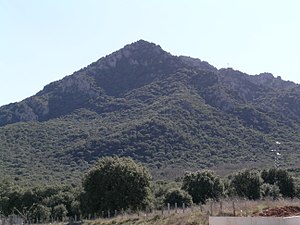
The lowest point across all the islands is the Southern Ocean at 0 pies (0 feet; 0 meters). The highest elevation across all the islands in Punto Colón in Esclaveta at 7,024 pies (6,421 feet; 1,957 meters). The highest point in Norental is Alto del Admiral at 3,412 pies (3,119 feet; 950 meters), the highest point in Colón is Punto de Cámarillo at 2,715 pies (2,482 feet; 757 meters), the highest point in Orisla is Volcán de Puro Oro at 3,292 pies (3,009 feet; 917 meters), and the highest point in Pescante is Punto 12 de Octubre at 2,570 pies (2,349 feet; 716 meters).
The San Carlos Islands has two major lakes: Admiral Lake at 256 pies deep (234 feet; 71 meters), and Silver Lake at 158 pies deep (144 feet; 44 meters). The San Carlos Islands has no major rivers, although, it does have various streams across the five island groups. The largest stream is the Stream of Liberty located in Esclaveta.
The San Carlos Islands is the only department of Creeperopolis not located in Sur. It is instead considered to be a part of Ostlandet due to its close proximity to New Gandor and Ajakanistan. It is completely surrounded by the Southern Ocean.
List of islands
The San Carlos Islands consists of 65 major islands: 4 in Norental, 6 in Colón, 8 in Esclaveta, 20 in Orisla, and 27 in Pescante. The archipelago also contains 59 other minor islands: 1 in Norental, 3 in Colón, 4 in Esclaveta, 17 in Orisla, and 34 in Pescante. In total, the archipelago contains 124 islands: 5 in Norental, 9 in Colón, 12 in Esclaveta, 37 in Orisla, and 61 in Pescante.
The following is a list of the major islands of each island group:
- Colón
- Esclaveta
- Norental
- Orisla
- Pescante
- Atlácatl
- Chepín
- Isla Amacha
- Isla Amara
- Isla Atonal
- Isla Chíhueta
- Isla de Alfonso
- Isla de la'Cruzada
- Isla de la'Nueva Luna
- Isla de los'Pescados
- Isla de Manuel
- Isla de Salvador
- Isla del Nuevo Sol
- Isla Grande†C
- Isla Iloqutzi
- Isla Imnoqueti
- Isla Llohechue
- Isla Martínez
- Isla Negra
- Isla Ribamar
- Isla Tzachu
- Isla Xuhuetí
- Machtitín
- Madero
- Nuevo Honduras
- Nuevo La'Libertad
- Nuevo San Romero
| Symbol | Notes |
|---|---|
| † | Largest island |
| C | Seat of capital |
Geology
The San Carlos Islands were formed by volcanic and tectonic activity at the bottom of the Southern Ocean between 3.5 million years ago and 500,000 years ago. The islands were formed by the San Carlosian hotspot, however, the hotspot last erupted around 120,000 years ago and is now considered to be extinct. No volcanic eruptions have been reported during the Creeperian occupation of the islands and no Native traditions describe any volcanic activity being present on the island. The only indication of volcanic activity as recent as 3500BC is that the Natives of the island call Punto Colón, the tallest point on the islands, as "Fire Land," however, the volcano is believed to have last erupted 120,000 year ago. Instead, it is believed that the Natives preformed religious rituals and ceremonies on the extinct volcano which involved fire in some capacity, a practice which has since been lost. As volcanic activity ceased over 120,000 years ago, the islands do not experience many earthquakes. The largest recorded earthquake occurred in Colón in 1598.
Climate
| Month | Jan | Feb | Mar | Apr | May | Jun | Jul | Aug | Sep | Oct | Nov | Dec | Year |
|---|---|---|---|---|---|---|---|---|---|---|---|---|---|
| Record high °F (°C) | 105.6 (40.9) |
107.2 (41.8) |
105.8 (41.0) |
102.7 (39.3) |
97.3 (36.3) |
96.6 (35.9) |
94.8 (34.9) |
102.0 (38.9) |
105.1 (40.6) |
109.0 (42.8) |
104.9 (40.5) |
109.8 (43.2) |
109.8 (43.2) |
| Average high °F (°C) | 86.4 (30.2) |
86.4 (30.2) |
84.9 (29.4) |
82.0 (27.8) |
79.5 (26.4) |
77.4 (25.2) |
77.0 (25.0) |
77.9 (25.5) |
77.7 (25.4) |
78.8 (26.0) |
81.3 (27.4) |
83.5 (28.6) |
81.1 (27.3) |
| Daily mean °F (°C) | 79.3 (26.3) |
79.9 (26.6) |
78.8 (26.0) |
75.9 (24.4) |
73.0 (22.8) |
71.2 (21.8) |
70.3 (21.3) |
71.2 (21.8) |
72.0 (22.2) |
73.2 (22.9) |
75.2 (24.0) |
77.5 (25.3) |
74.8 (23.8) |
| Average low °F (°C) | 73.9 (23.3) |
74.3 (23.5) |
73.9 (23.3) |
71.4 (21.9) |
68.7 (20.4) |
65.7 (18.7) |
65.1 (18.4) |
66.0 (18.9) |
66.6 (19.2) |
68.4 (20.2) |
70.5 (21.4) |
72.3 (22.4) |
69.8 (21.0) |
| Record low °F (°C) | 63.9 (17.7) |
66.0 (18.9) |
65.5 (18.6) |
61.2 (16.2) |
52.0 (11.1) |
52.9 (11.6) |
54.0 (12.2) |
51.1 (10.6) |
50.4 (10.2) |
50.2 (10.1) |
59.2 (15.1) |
62.8 (17.1) |
50.2 (10.1) |
| Average precipitation inches (mm) | 3.40 (86) |
3.13 (80) |
4.35 (110) |
6.74 (171) |
7.75 (197) |
8.68 (220) |
8.65 (220) |
7.75 (197) |
6.11 (155) |
5.41 (137) |
4.28 (109) |
3.67 (93) |
69.92 (1,776) |
| Source: Cámarillo Meteorological Institute | |||||||||||||
Demographics
Population
| Year | Pop. | ±% |
|---|---|---|
| 1387 (est.) | 223,584 | — |
| 1565 | 532,182 | +138.0% |
| 1749 | 957,715 | +80.0% |
| 1833 | 1,522,118 | +58.9% |
| 1887 | 2,138,118 | +40.5% |
| 1949 | 4,631,228 | +116.6% |
| 1981 | 5,582,119 | +20.5% |
| 1995 | 6,133,288 | +9.9% |
| 2010 | 7,391,338 | +20.5% |
| 2020 | 8,517,685 | +15.2% |
The population of the San Carlos Islands before 1387 is unknown, but Creeperian estimates at the time and in the following centuries placed the population in 1387 at around 220,000 total inhabitants. During the period known as "The Enslavement," thousands of Natives died due to disease, war, and other deaths relating to their poor conditions living on the island. Such death tolls reduced the population of the islands, however, the actual death tolls are unknown as no proper figures were ever recorded and no population estimated were made between 1387 and 1565. During the period known as "The Liberation," however, the population increased significantly, recovering to the original 1387 population, and even over doubling it by 1565 when the population reached 532,182.
A census in 1749 listed the total population of the islands at 957,715. Estimates from 1833 record the population as being 1,522,118, the first time the population of the islands has ever officially been over 1 million in its history. The population continued to steadily increase each year, and during the Creeperian Civil War, the population of the department continued to increase, the only department in Creeperopolis in which the population did not decrease due to the war. During the war, hundreds of thousands of refugees took refuge in the islands, increasing its population even further.
As of 2020, the population of the San Carlos Islands is 8,517,685. The average age in the San Carlos Islands is 28.41 years. The fertility rate of the department is 3.1 children per woman. The life expectancy in the San Carlos Islands in 2020 was 73.11 years for males and 78.53 years for females.
Ethnicity
Composition
The San Carlos Islands is the only department of Creeperopolis to not be composed of a majority of ethnic Creeperans. The majority of the population is ethnically Natizo, or an individual with both Creeperian and Native ancestry, and compose 85.45 percent of the population. Creeperans compose 9.16 percent and Natives compose 5.28 percent, respectively. Among Natives, Esclavetans compose 2.70 percent of the total populaiton, or 51.17 percent of all Natives. Other ethnic groups, such as Senvarians, Castillianans, Atlántidans, Paleocacherians, and Reians, compose only 0.11 percent of the population. During the Captaincy General, a population of enslaved Deltinians existed on the island, however, most of them were killed during the Second Great Persecution of Deltinian Islam of 1833 to 1887.
| Ethnic group | Percentage | Population | |
|---|---|---|---|
| Natizo | 85.45% | 7,278,283 | |
| Creeperian | 9.16% | 780,220 | |
| Native Islander | 5.28% | 449,734 | |
| Subgroups | Esclavetans | 2.70% | 230,119 |
| Colónes | 0.98% | 83,178 | |
| Pescantes | 0.61% | 52,118 | |
| Norentales | 0.59% | 50,128 | |
| Orislas | 0.40% | 34,191 | |
| Other | 0.11% | 9,448 | |
| Subgroups | Castillianans | 0.04% | 3,318 |
| Atlántidans | 0.02% | 1,448 | |
| Senvarians | 0.02% | 1,338 | |
| Paleocacherians | 0.01% | 1,160 | |
| Reians | 0.01% | 912 | |
| Other | 0.01% | 1,272 | |
| Total | 100% | 8,517,685 | |
- Natizo men
- Natizo women
- Natizo children
- Creeperian men
- A Creeperian woman
- Creeperian children
- A Native woman
- Native girls
- Native girls
Caste system
Under Gutiérrez Valdivia, a caste system was established to separate the population of the Captaincy General by race and ethnicity. It was is effect from 1400 until it was abolished in 1565. The caste system was called the Casta and it was composed of sixteen castes. The castes were:
- Creeperian with Native, Natizo
- Natizo with Creeperian, Cartizo
- Cartizo with Creeperian, Creeperian
- Creeperian with Deltinian, Delato
- Delato with Creeperian, Delo
- Delo with Creeperian, Chino
- Chino with Native, Detizo
- Detizo with Delato, Deltato
- Deltato with Chino, Jíbaro
- Jíbaro with Delato, Albarazado
- Albarazado with Deltinian, Cambujo
- Cambujo with Native, Zambiaga
- Zambiaga with Deltato, Calpamulato
- Calpamulto with Cambuja, Morisca
- Morisca with Delato, Delisca
- Delisca with Native, Detiva
Today, practically none of the terms of the castes, except Natizo, are used in the San Carlos Islands. Individuals with both Native and Creeperian ancestry are simple referred to as Natizo.
Use of slavery
During Colón Cámarillo's second voyage, he and his crew landed on the island of Esclaveta. During their time there, they settled near a Native settlement of 200 people. On 4 October 1385, a fight erupted between the Creeperans and the Natives. The reason for the fight is unknown, but it is speculated to have been over the Creeperian settlement or the Creeperian use of the land while they were settled there. During the fight, eight people were killed, with four deaths on both sides. Around thirty others were injured in the fight. The Natives demanded that the Creeperans never return to the island, and the Creeperans left for Salvador the next day.
Colón Cámarillo did not forget about the fight when he returned to the San Carlos Islands to serve as its Captain General. On 4 October 1388, exactly three years after the fight, he ordered the enslavement of all adult male the Natives on the island where the fight occurred. In the declaration, he established the municipality of Esclaveta, meaning "Land of Slavery." He strictly forbade enslavement of women, children, and the elderly. He stated that he wanted to "punish those who hurt us, not those who have done nothing to us."
In November 1388, he commanded a fleet of four ships with 800 men to subjugate the island and enslave the people. The fleet landed on 14 December 1388, roughly near where the fight occurred three years earlier. They found the Natives that had attacked them and moved to capture them. The Natives fought back, but the Creeperans managed to capture most of the Natives, with the remainder fleeing or being killed. Any women, children, and elderly captered were released. The event began the Esclaveta War which lasted until 1401 where the Creeperans launched attacks against the Natives to subjugate them into slavery and the Natives launched attacks on the Creeperans to maintain their freedom. The struggle was in vain, however, and most of the Native population was enslaved, with the remainder somehow fleeing north to other islands or dying during the struggle for freedom.
When Colón Cámarillo was Captain General, bloodshed was not very common, with light skirmishes and scarce engagements being the norm. When Gutiérrez Valdivia became Captain General, however, violence and battles became commonplace, with many massacres being committed by Creeperian soldiers against Native warriors and even Native women and children and elderly who were noncombatants, against the wishes of Colón Cámarillo. The massacres committed under Gutiérrez Valdivia from 1392 until the war's end in 1401 are known as the Esclaveta Genocide, where around 18,000 Natives were killed out of a total population of around 44,000 people, approximately 41 percent of the total population of Esclaveta.
During Gutiérrez Valdivia's tenure as Captain General, the Natives of Esclaveta were forced to work on plantations, in mines, and at construction sites across the Captaincy General. Men and teenage boys were the ones sent to the mines and construction sites, while women, girls, the elderly, and younger boys were sent to plantations, ignoring what Colón Cámarillo had strictly stated. Around 30 percent of the population remained on Esclaveta to repopulate and continue "producing fresh slaves" for the Captaincy General.
There were specific punishments handed down to slaves for committing certain acts. Escaping, attempting an escape, murder, attempted murder, and rape were punished by death. Refusing to work, robbery/theft, and other miscellaneous crimes were punished by torture. Methods of torture included whipping, flogging, and burning.
The rule of Gutiérrez Valdivia is considered the darkest period in San Carlos Islander history. In total, around 55,000 to 100,000 Natives died during his tenure from 1392 to 1412. Palafox Mendoza later remarked in 1692 that "[Gutiérrez Valdivia's] tenure of twenty years was the worst twenty years in the history of this small archipelago in the [Southern] Ocean." The early military rule from 1392 through 1477 is commonly referred to as "The Enslavement" due to the brutality of the Captain Generals. Gutiérrez Valdivia's successors, Hurtado Mendoza (1412–1427), Quiroga López (1427–1463), and Bravo Saravia (1463–1477), all continued his legacy and policies of anti-Nativism and brutality.
Several slave revolts occurred when slavery was legal. The first occurred in 1412 against Hurtado Mendoza after Gutiérrez Valdivia was assassinated by a slave in Cámarillo. The revolt was crushed by the end of the year. Another revolt occurred in 1431 after 62 slaves were killed due to their alleged involvement in Hurtado Mendoza's death which was also crushed by the end of the year. The largest revolt, the Great Revolt of Esclaveta, lasted from 1440 to 1442. It was led by Kapahu I and his son, Kila I. It resulted in an estimated 45,000 dead Natives.
In 1463, Bravo Saravia abolished slavery for women, children, and the elderly, but slavery for men persisted. Slavery was completely abolished and made illegal by Óñez Barrera on 18 August 1478 after pressure from Native slaves and his Native wife in the Proclamation of Liberation. Slavery returned in Esclaveta during the self-proclaimed republic from 1522 until the republic was crushed in 1524.
Religion
The official and main religion of the San Carlos Islands is Creeperian Catholicism under the theology and doctrine of the Creeperian Catholic Church. The Church is led by the Pope, and during the Captaincy General, the Papacy approved of the conversion of the Natives of the archipelago. Most of the archipelago's Natives were converted to Creeperian Catholicism, either willingly or through force. The practicing of the religion was a requirement for government benefits, and refusing to convert was faced with punishments of forced labor, torture, exile, or death.
On 12 October 1390, Pope Boniface IX established the Archdiocese of the San Carlos Islands and consecrated Pedro Moya Contreras as its first archbishop. The archdiocese is one of the largest in Creeperopolis in terms of land area, but is the smallest in terms of population.
In 1402, Gutiérrez Valdivia ordered the construction of two missions in the San Carlos Islands, one in Cámarillo and one in San Nicolás. The mission in Cámarillo, the San Carlos Mission, was built from 1403 to 1411, while the mission in San Nicolás, the San Nicolás Mission, was built from 1405 to 1411. Both were consecrated in 1411 and began church services. Tens of thousands of baptisms, confirmations, marriages, burials, and conversions occurred at the two missions. The San Carlos Mission was destroyed in 1938 during the Creeperian Civil War and remains in ruins, currently serving as a museum. The San Nicolás Mission remains intact and continues church services, although, the San Nicolás Cathedral, directly next to the mission, carries out most of the church services in the area.
Seven saints were canonized by the Creeperian Catholic Church that were born in the San Carlos Islands. Those saints include:
- Miguel Zumárraga Arrazola (1533–1593), Archbishop of the San Carlos Islands (1574–1593)
- Diego Cosnvarubias Torres (1542–1602), witnessed four apparitions of Our Lady of Guadeloupe in 1575
- Juan Palafox Mendoza (1652–1736), Archbishop of the San Carlos Islands (1682–1736), Captain General of the San Carlos Islands (1685–1736)
- Melina González Carpio (1734–1791), founder of the San Carlos Islands Catholic Community of Native Islanders
- Bertila Campaña Tejón (1841–1867), missionary martyred by Native Islanders
- Ana Huerta Olague (1843–1867), missionary martyred by Native Islanders
- María Encarnación Yaliva (1844–1867), missionary martyred by Native Islanders
Today, the majority of the population of the San Carlos Islands is Creeperian Catholic. In 2020, 72.44 percent of San Carlos Islanders attended church services on a weekly basis. The San Carlos Islands has five patron saints: Saint Carlos, Saint Miguel, Saint Diego, Saint Juan, and Saint Melina.
Languages
The official and dominant language of the San Carlos Islands is Creeperian Spanish. The Creeperian government lists that every Natizo and Creeperian is fluent in the language, and estimates that around 45 to 60 percent of all Natives are able to speak the language as either a primary or secondary language. Native languages are also spoken. The largest spoken language is Esclavetan, which has since been simply known as the "Native Islander language," however, distinct languages are also spoken, known as Colónese, Pescantero, Noreteño, and Orisleño.
Government and politics
Captain General
The Captain General of the San Carlos Islands is the official governor of the San Carlos Islands. The Captain General also has a seat in the Council of Captain Generals, the upper house of the General Courts. The Captain General is appointed by the Emperor of Creeperopolis and answers directly to him. The Captain General acts as the administrator of the San Carlos Islands and has practically very little restrictions and checks on their power and ability to carry out executive actions, effectively making the Captain General a de facto dictator.
The current Captain General of the San Carlos Islands is Sergio Rodolfo Tejón Galdámez of the Creeperian Initiative. He was born on 22 January 1970 in Cámarillo and served in the Creeperian Army during the first phase of the San Carlos Islands Crisis in the 21st Creeperian Army from 1988 to 1996, attaining the rank of Sergeant. He later studied and graduated from the Cristóbal Colón Cámarillo University. He served as the Mayor of San Nicolás from 2005 to 2009, when he was reassigned to serve as Mayor of Cámarillo. He became Captain General of the San Carlos Islands on 1 March 2011.
Since its establishment in 1387, 34 men have held office, six of whom were from the Mendoza Family, and there have been 38 Captaincy Generalships. Several political parties have held the position of Captain General: the Liberal Party (LP), the Conservative Party (CP), the National Liberal Party (PLN), the Catholic Royalist Party (PRC), the Creeperian Socialist Party (PSC), the National Conservative Party (PCN), and the Creeperian Initiative (IRCCN y la'FPPU). Since 1949, however, the only legal political party in the San Carlos Islands has been the Creeperian Initiative. The military has also held the position on several occasions.
Departmental ministries and ministers
| Ministries of Sergio Tejón Galdámez | |
|---|---|
| Date formed | 1 March 2011 |
| People and organisations | |
| Captain General | Sergio Tejón Galdámez |
| Captain General's history | 1 March 2011 – present |
| No. of ministers | 6 |
| Total no. of members | 8 |
| Member party | Creeperian Initiative |
| Status in legislature | Government |
Each of the Ministries of Creeperopolis, except for the Ministry of Defense, the Ministry of Intelligence, and the Ministry of External Affairs, appoint department-level ministers and ministries to govern the San Carlos Islands, with approval of the department's Captain General, just as is done for the other twenty-nine departments of Creeperopolis.
| Ministers of the San Carlos Islands | |||
|---|---|---|---|
|
Individual serving in an acting capacity
| |||
| Ministry | Minister | Assumed office | Time in office |
 – Ministry of Internal Affairs |
 Minister of Internal Affairs José Mendoza Sequeira of Cámarillo |
3 March 2011 | 13 years, 65 days |
 – Ministry of Law Enforcement |
 Minister of Law Enforcement Félix Maradiaga Blandón of Arcángel |
2 March 2011 | 13 years, 66 days |
 – Ministry of the Treasury |
 Minister of the Treasury Orlando Alvarado Hernández of San Nicolás |
2 March 2011 | 13 years, 66 days |
 – Ministry of Labor |
 Minister of Labor Antonio Álvarez Arias of Anadesa |
18 September 2015 | 8 years, 232 days |
 – Ministry of Education |
 Minister of Education Porfirio Pineda Ponce of Cámarillo |
3 March 2011 | 13 years, 65 days |
 – Ministry of Transportation |
 Minister of Transportation Manuel Zelaya Rosales of Anadesa |
4 July 2017 | 6 years, 308 days |
Municipalities
The San Carlos Islands is composed of five municipalities.
| Map | Flag | Municipality | Capital | Largest City | Population (2020) |
Viceroy |
|---|---|---|---|---|---|---|

|

|
Colón | Cámarillo | Cámarillo | 2,644,558 | Eduardo Monterrosa Sandoval |

|

|
Esclaveta | Anadesa | Anadesa | 1,592,229 | Socrátes Bermúdez Fuentes |

|

|
Norental | Arcángel | Arcángel | 2,119,329 | Ismael Quijada Menjíva |

|
Orisla | San Nicolás | San Nicolás | 1,122,013 | Romero Carpio Barranca | |

|

|
Pescante | Cena | Cena | 1,039,229 | Julio Zapata Figueroa |
Cities
The San Carlos Islands has 52 incorporated cities across all five municipalities. The department's capital city is Cámarillo and the first Creeperian city established on the islands was San Nicolás on 1 November 1381 by Colón Cámarillo.
| Rank | Municipality | Pop. | Rank | Municipality | Pop. | ||||
|---|---|---|---|---|---|---|---|---|---|
 Cámarillo  San Nicolás |
1 | Cámarillo | Colón | 1,165,658 | 11 | Desayuno | Pescante | 76,818 |  Anadesa  Cena |
| 2 | San Nicolás | Orisla | 482,118 | 12 | Ciudad Gutiérrez Rubalcava | Colón | 60,135 | ||
| 3 | Anadesa | Esclaveta | 456,229 | 13 | Ciudad de Adolfo I | Esclaveta | 54,122 | ||
| 4 | Cena | Pescante | 244,119 | 14 | Pensacola | Esclaveta | 48,709 | ||
| 5 | Arcángel | Norental | 232,118 | 15 | Ciudad Gutiérrez Avendaño | Colón | 46,273 | ||
| 6 | Puerto de Nueva Tierra | Norental | 165,846 | 16 | Ciudad de Norental | Norental | 43,959 | ||
| 7 | Guadeloupe | Esclaveta | 155,658 | 17 | La'Libertad | Esclaveta | 41,761 | ||
| 8 | Ciudad Palafox Mendoza | Esclaveta | 116,744 | 18 | Almuerzo | Pescante | 39,672 | ||
| 9 | Ciudad de Oro | Orisla | 100,580 | 19 | Ciudad de Plata | Orisla | 37,688 | ||
| 10 | Santa Catalina | Colón | 84,243 | 20 | San Juan | Esclaveta | 35,803 | ||
Armed forces
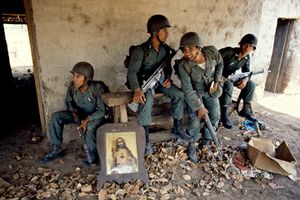
The 21st Creeperian Army, nicknamed the Army of Our Lady of Guadeloupe, is permanently garrisoned in the San Carlos Islands, and has been since the outbreak of the San Carlos Islands Crisis in 1981. The army is headquartered in Cámarillo out of the José Hernández Córdoba Military Base, but it also has a presence in every municipality. The army is commanded by General Augusto Berger Perdomo. The 25th Creeperian Air Force Wing is also permanently garrisoned in the San Carlos Islands and is also headquartered in Cámarillo out of the Juan Palafox Mendoza Air Force Base. It is commanded by General Antonio Somoza Trujillo.
The naval presence on the San Carlos Islands has historically been the most significant as it was the Navy that initially discovered the islands in 1381. Several different naval units have been garrisoned at the islands overtime. Currently, the 19th Creeperian Flotilla is garrisoned in the San Carlos Islands. It is headquartered in San Nicolás at the Admiral Cristóbal Colón Cámarillo Naval Base, although, like the army, it also has a presence in every municipality. Its secondary bases include Admiral Ramón Cisneros Jiménez Naval Base in Cámarillo, Admiral José Gutiérrez Rubalcava Naval Base in Anadesa, Rear Admiral Jerónimo Cabrera Salinas Naval Base in Cena, and Admiral Gustavo Montojo Pasarón Naval Base in Arcángel. The navy is commanded by Admiral Romero Duarte Magaña.
Territorial dispute with Ajakanistan
On 15 May 1986, the nation of Ajakanistan claimed territory in the municipality of Norental, specifically the entirety of the islands of Isla Verde, Paleto, Punto Norentisimo, and the northern half of the island of Admiral, as a part of its campaign to support the MRKA during the San Carlos Islands Crisis. The Ajaki government planned to incorporate the territory as a state called Norilsk so that it could have a military presence on the island, however, no attempt was made and the Creeperian government retains complete control of the San Carlos Islands.
Economy

The economy of the San Carlos Islands is one of the most important in Creeperopolis. The nominal gross domestic product (GDP) of the San Carlos Islands in 2020 was worth ₡3.52 trillion Creeperian Colóns,[note 1] making it on of the largest departmental GDPs of Creeperopolis. The large GDP accounted for a GDP per capita figure of ₡381,559 Creeperian Colóns,[note 2] one of the highest in Creeperopolis. The San Carlos Islander economy is primary reliant on tourism, mining, and fishing.
The poverty rate in the San Carlos Islands is 8.43 percent, however, among Natives, the figure is much higher at 17.44 percent, while among Creeperans, the figure is only 2.11 percent. As of September 2020, there were 5,877,201 people employed, either full- or part-time, with an unemployment rate of 3.81 percent.
Tourism
Mining
Mining has historically been the largest sector of the San Carlos Islander economy and the pursuit of gold in the archipelago by the Creeperian explorers and settlers led to the establishment of gold mines across the islands. Gold was the most sought after mineral and came to be a symbol of the San Carlos Islander economy. The San Carlos Islands itself was named after Saint Carlos, and one of his attributes is gold. During the first military administration and First Parliamentary Era, the San Carlos Islands accounted for 40 percent of gold mining in Creeperopolis. Mineral mining continues to be an important sector of the San Carlos Islander economy, accounting for 16.44 percent of the department's annual GDP in 2020. Most of the mines in the department are controlled by the National Mining and Smelting Corporation (CORNAMIF).
Natural gas mining accounts for another 5.33 percent of the economy. In the 1950s, the Creeperian Petroleum Corporation (PETRÓCRE) began drilling in the waters of the San Carlos Islands off the coast of Orisla in search of undersea oil deposits. Instead, PETRÓCRE found undersea natural gas deposits. Further natural gas deposits were found off the coasts of Colón and Norental. The corporation began offshore operations to extract the natural gas. Most of the natural gas extracted by PETRÓCRE is only sold locally within the San Carlos Islands. In 1983, PETRÓCRE concluded that no major undersea oil deposits were present in the San Carlos Islands.
Fishing

Fishing is one of the largest industries in the San Carlos Islands. Although fishing occurs all across the archipelago, most fishing businesses are focused in and conduct most of their fishing operations in the municipality of Pescante. When the Creeperans first arrived to Pescante, they encountered Natives who have mastered fishing in the waters around the islands, and since then, Creeperian fishing companies mainly focused on fishing in the area. The area in general has the most abundance of fish, and Pescante itself literally means "Place of Fish." Most fisheries are located in the municipal capital city of Cena.
The most common types of fish caught in Pescante are mackerel, tuna, and bluefish. A Class C Fishing License is required to commercially fish mackerel, tuna, and bluefish. Sharks and swordfish are also fished in the waters of Pescante, however, a Class B Fishing License is required to fish sharks and swordfish. Halibut is a species introduced to the waters by the Creeperans in the 1400s, and fishing halibut required a Class C Fishing License. These same types of fish and their respective licenses apply across the rest of the islands. Other Class B fish include octopi and squid. Most other fishes require only a Class C license. Although commercial whaling was banned by Terraconserva Council of Nations General Assembly Resolution 8 in 2020, the San Carlos Islands has continued to issue Class A licenses and allows commercial whaling in its waters.
Fishing laws are very lax in the San Carlos Islands, however, they are more restrictive in Colón. Heavy fines are imposed for killing whales or dolphins across the five municipalities. Before 1821, the San Carlos Islands Fishing Company was the only fishing company allowed in the islands, however, a reform bill allowed for new companies to fish in the islands. During the San Carlos Islands Crisis, the Creeperian Navy was deployed to protect fisheries and fishing companies from attacks from rebel groups.
| Company | Country | Year began fishing | Location(s) | License(s) | Fish caught | Fish caught in MT in 2020 |
|---|---|---|---|---|---|---|
| Colón Cámarillo Fishing | 1900 | B, C | Squid, Octopi, Tuna, Mackerel | 13,000 | ||
| Kalastus Kollektiv | 1976 | C | Tuna, Mackerel, Halibut | 20,000 | ||
| Karlos-Karimun Maritime Corporation | 1988 | B, C | Mackerel, Tuna, Squid, Bluefish, Halibut, Seaweed | 62,000 | ||
| Norental Fishing | 1967 | C | Tuna, Mackerel | 7,000 | ||
| San Andrés and San Pedro Fishing | 1891 | A, B, C | Whales, Swordfish, Squid, Octopi, Tuna, Mackerel, Halibut | 52,500 | ||
| San Carlos Islands Fishing Company | 1836 | A, B, C | Whales, Swordfish, Squid, Tuna | 35,100 | ||
| Sgrùdadh Goireasan Cuan Einfeld | 1990 | C | Tuna, Halibut | 32,000 |
Infrastructure
Transportation
The infrastructure of the San Carlos Islands is considered to be one of the most well-maintained and well-developed in Creeperopolis.
Roads
The San Carlos Islands, like the other departments of Creeperopolis, has its own internal highway network: the San Carlos Islands Highway System. The five departmental highways in the San Carlos Islands are the ISC 1 (Cámarillo, Colón), ISC 2 (Santa Catalina, Colón), ISC 3 (Esclaveta, Esclaveta), ISC 4 (Admiral, Norental), and the ISC 5 (Isla de Oro, Orisla). Due to the small sizes of the islands in Pescante, no departmental highway exists in the Pescante municipality. Additionally, no national-level highway exists in the San Carlos Islands, the only department without a highway of the Creeperian Highway System.
Airports and seaports
Travel by air and sea is the only practical way to travel between the municipalities of the San Carlos Islands and abroad to the rest of Creeperopolis and to other countries. Domestically, both air and sea travel share similar amounts of passenger usage, but with the rest of Creeperopolis and internationally, travel by air is the most popular method of transportation.
Creeperian Airlines flies regular flights between the San Carlos Islands and the mainland, and the San Carlos Islands has its own airline, Volaris, which mainly flies routes between the municipalities of the island. The largest airports of each municipality are:
- Cristóbal Colón Cámarillo International Airport (Colón)
- San Nicolás de Oro International Airport (Orisla)
- Anadesa–Libertad International Airport (Esclaveta)
- Cena International Airport (Pescante)
- International Airport of the Archangels (Norental)
Sea travel between the municipalities is frequent. The Gold Star Line also operates a route to both the mainland and to Quebecshire, known as the Salvador–Bostonia–Cámarillo route between Cámarillo, Salvador, and Bostonia, on the MV Cristóbal Colón Cámarillo cruise ship. The largest seaports of each municipality are:
- Puerto Admiral Cristóbal Colón Cámarillo (Colón)
- Puerto del Santo Carlos de Oro (Orisla)
- Puerto de Anadesa–Libertad (Esclaveta)
- Puerto de Cena (Pescante)
- Puerto Norte (Norental)
A ferry between the islands of Cámarillo and Santa Catalina also occurs three times per day on both directions which offers a third option for connection between the two islands.
Education
Primary and secondary education
School attendance, or registration for home schooling, is compulsory in the San Carlos Islands. Education in the department is administered by the Ministry of Education of the San Carlos Islands, which itself is administered by the Ministry of Education of Creeperopolis. Children are required to attend school from the age of 5 until the age of 16. Public schools are directly operated, funded, and managed by the Ministry of Education. Adult literacy in the San Carlos Islands is estimated to be around 97 percent, the highest among the departments of Creeperopolis.
Colleges and universities
In total, the San Carlos Islands has five private colleges and universities and seven more public colleges and universities. The five private universities of the San Carlos Islands are all operated, funded, and managed by the Creeperian Catholic Church. Public colleges and universities are directly operated, funded, and managed by the Ministry of Education. Both public and private colleges and universities in the San Carlos Islands are considered to be some of the most expensive in Creeperopolis.
- Public
- Cena University, Cena
- Cristóbal Colón Cámarillo University, Cámarillo
- University of Anadesa, Anadesa
- University of Guadeloupe, Guadeloupe
- University of San Carlos, Ciudad de Oro
- University of San Nicolás, San Nicolás
- University of the Archangels, Arcángel
- Private
- San Carlos University, Puerta de Nueva Tierra
- San Nicolás University, San Nicolás
- University of San Juan Palafox Mendoza, Cámarillo
- University of the Martyrs, Arcángel
- University of the Sacred Heart, Santa Catalina
Culture
| San Carlos Islands department symbols | |
|---|---|
 | |
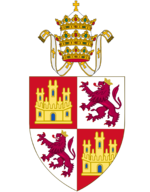 | |
| Living insignia | |
| Bird | San Carlosian Condor |
| Cat breed | Calico |
| Dog breed | Alano |
| Fish | Tuna |
| Flower | San Carlosian Blossom |
| Tree | Maquilishuat |
| Inanimate insignia | |
| Beverage | Pilsener |
| Colors | Red and white |
| Firearm | Figueroa-24 |
| Folk dance | Natezero |
| Food | Pupusas con tuna |
| Gemstone | Emerald |
| Mineral | Gold |
| Motto | Viva y Salve las'Islas de San Carlos |
| Nickname | Nuevo Salvador |
| Poem | Viva y Salve |
| Rock | Basalt |
| Ship | BIC San Carlos Islands |
| Song | Viva y Salve |
| Sport | Association football |
| Department route marker | |
 | |
Public holidays
The San Carlos Islands celebrates the same nineteen national holidays as all the departments of Creeperopolis have to celebrate and recognize by law. The nineteen national holidays which are celebrated are:
| Date | Holiday |
|---|---|
| 1 January | New Year's Day |
| 8 February | Independence Day |
| March/April | Holy Week/Easter |
| 3 May | The Day of the Cross/Festival of the Crosses |
| 10 May | Mother's Day |
| 17 June | Father's Day |
| 18 June | Liberation Day |
| 24 June | Division Day |
| 23 August | Triumvirate Day |
| 15 September | Day of the Creeperans/Coronation Day |
| 30 September | Feast Day of Saint Romero I |
| 1 October | Children's Day |
| 12 October | Colón Cámarillo Day |
| 1 November | All Saints' Day |
| 2 November | Day of the Dead |
| 7–13 November | National Pupusa Festival |
| 25 December | Christmas Day/Crusaders' Day |
| 28 December | Day of the Holy Innocents |
| 31 December | New Year's Eve |
On four of those national holidays, Good Friday, Easter, Liberation Day, and Christmas, schools are prohibited from holding classes and employees are mandated to be paid overtime by their employers if they work on those four days.
The San Carlos Islands also celebrates and recognizes five departmental holidays, one of which overlaps with an already existing national holiday. The five additional departmental holidays are:
| Date | Holiday |
|---|---|
| 19 January | Department Day |
| 1 June | Establishment Day |
| 12 October | Feast Day of Saint Juan |
| 11 December | Feast Day of Saint Carlos |
Like the four special national holidays, employers and mandated to pay their employees overtime for working on Establishment Day, the Feat Day of Saint Juan, and the Feast Day of Saint Carlos, and schools are prohibited from holding classes on the Feast Day of Saint Juan and the Feast Day of Saint Carlos, but they are allowed to hold classes on Establishment Day.
Cinema and film
The San Carlos Islands is considered to be a "bastion" of cinema and film in Creeperopolis, being the birthplace of several famous Creeperian actors and directors. One of the most iconic actors who was born in the San Carlos Islands was Tomás Gómez Alvarado, the creator of the popular sitcom El Chavo which aired from 1970 until 1979. Other notable San Carlosian actors include Guillermo Durán Olmos, Estela Díaz Barrios, José Hernández Salinas, Julia Casanova Velázquez, and Cassandra Pérez Carpio.
The San Carlos Islands has also been the basis and setting for several movies, films, and television episodes and series. The most famous film set in the San Carlos Islands is the 1970 film Cámarillo, starring Héctor Galdámez Casanova as the lead role of Archbishop and Captain General Juan Palafox Mendoza and directed by José Regalado Sandoval. The film was set around the events of the Cámarillo massacre of 1712 and it is considered to be one of the greatest films in Creeperian history. The most notable short film set in the San Carlos Islands is the 1996 short film Oda a las'Islas San Carlos featuring Damián López Curbelo as the lead role of Carlos. Other films set in the San Carlos Islands include Fuí Sin Amor (2003), La'Vida deun Multimillonario (2020), and Dondé (1995).
Media
Telecommunication in the San Carlos Islands is largely provided by three satellite and cable companies: Claro, TeleNación, and Tigo. As required by law, all three primary providers provide access to channels 1 through 36. In 2020, Channel 31 was reported to be the most viewed television channel in the San Carlos Islands, followed by Channel 4, Channel 32, Channel 12, and Channel 11.
Cuisine
Cuisine in the San Carlos Islands is considered to be the most "diverse" among the Creeperian departments due to the contact made with the Native San Carlos Islanders. The San Carlos Islands, like San Pedro and the Atlántidan departments, place a large emphasis on the consumption of fish. Cuisine generally is a Creeperian dish mixed with fish which has been historically fished by Native San Carlos Islanders, such as pupusas being filled with local tuna and pasteles being stuffed with local mackerel, squid, and sometimes even swordfish.
Until 2020, sometimes, whale was also served, however, with the passage of TCN Resolution 008, the commercial sale of whale was made illegal.[1] Whale, however, can still be bought illegally on the black market, which the Creeperian government has made efforts to crack down on to bring the department into full compliance with TCN Resolution 008. A ₡250,000 colón[note 3] fine and five years imprisonment has been instituted as the penalty for illegally purchasing whale meat and a ₡500,000 colón[note 4] fine and ten years imprisonment has been instituted as the penalty for illegally whaling and/or selling whale meat.
Literature

Several famous poets have been born in the San Carlos Islands, including José Menéndez Menéndez, Antonio Mendoza Figueroa, Carmen Hernández Funes, Natalia Guzmán Dávalos, and Julia Salinas Casanova. Several poems have also been written about the San Carlos Islands, most notably the poem Viva y Salve written by Antonio Batrés González in circa 1396.
| Viva y Salve | Hail and Praise |
|
|
Dance and music
Dance and music in the San Carlos Islands has been heavily influenced by both traditional Creeperian and Native San Carlos Islander dances. The style of dance known as Natezero evolved during the First Parliamentary Era as a blend of both Creeperian and Native traditional dances and has become the departmental dance of the San Carlos Islands. The music style of Natizaro also evolved in similar conditions: during the First Parliamentary Era as a blend of both Creeperian and Native traditional music.
Departmental anthem
The San Carlos Islands is one of the few departments to have a departmental anthem. The anthem, Viva y Salve (Creeperian: Վիվա յ Սալվե; translated as Hail and Praise) was adopted sometime during the first military administration of the islands from 1396 to 1565. The anthem gained its official status as the regional anthem on 18 March 1565. When the San Carlos Islands became a department, the anthem was reconfirmed as the departmental anthem of the San Carlos Islands.
| Iberic lyrics | Creeperian lyrics | Lyoan translation |
|---|---|---|
| CORO 𝄆 ¡Viva y Salve las'Islas de San Carlos, ESTROFA CORO |
ԾՈՐՈ 𝄆 ¡Վիվա յ Սալվե լաս'Իսլաս Սան Ծարլոս, ԵՍՏՐՈՖԱ ԾՈՐՈ |
CHORUS 𝄆 Hail and Praise the San Carlos Islands, VERSE CHORUS |
Sports

The San Carlos Islands is home to thirteen professional sports teams across three different sports. Football is by far the most popular sport in the San Carlos Islands, as it is in the rest of Creeperopolis. There is also a significant following for beach football and baseball. An estimated 85.55 percent of San Carlos Islanders have stated that they follow at least one professional sports team.
Several referees for the National Football Association also originate from the San Carlos Islands, including Martín Tejón Umaña, Alexander Bolívar Nariño, Gregorio Fuentes Fuentes, José Gómez Gullén, and Armando López Dávalos.
Twinned cities
Cámarillo is twinned with:
San Nicolás is twinned with:
Arcángel is twinned with:
Anadesa is twinned with:
See also
Notes
References
- ↑ Cite error: Invalid
<ref>tag; no text was provided for refs namedTCN Resolution 008
Further reading
External links

|
LCN Wiki has media related to the San Carlos Islands. |
| Preceded by Native San Carlos Islander Tribes and Nations |
Captaincy General of the San Carlos Islands 1 June 1387 – 19 January 1888 |
Succeeded by Captaincy General and Department of the San Carlos Islands |
| Preceded by Captaincy General of the San Carlos Islands |
Captaincy General and Department of the San Carlos Islands 19 January 1888 – present |
Succeeded by Current government |
- Pages with reference errors
- Good articles
- Articles with short description
- Use dmy dates from August 2021
- Pages using infobox settlement with bad settlement type
- Pages using infobox settlement with possible nickname list
- Pages using infobox settlement with possible motto list
- Portal templates with all redlinked portals
- Portal-inline template with redlinked portals
- Pages using multiple image with auto scaled images
- Pages using infobox government cabinet with government head history
- Creeperopolis
- Creeperopolis RP
- Creeperopolis Terraconserva
- Terraconserva
- San Carlos Islands
- Creeperian Conflicts
- San Carlos Islands Crisis
- Departments of Creeperopolis


